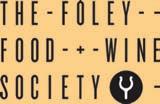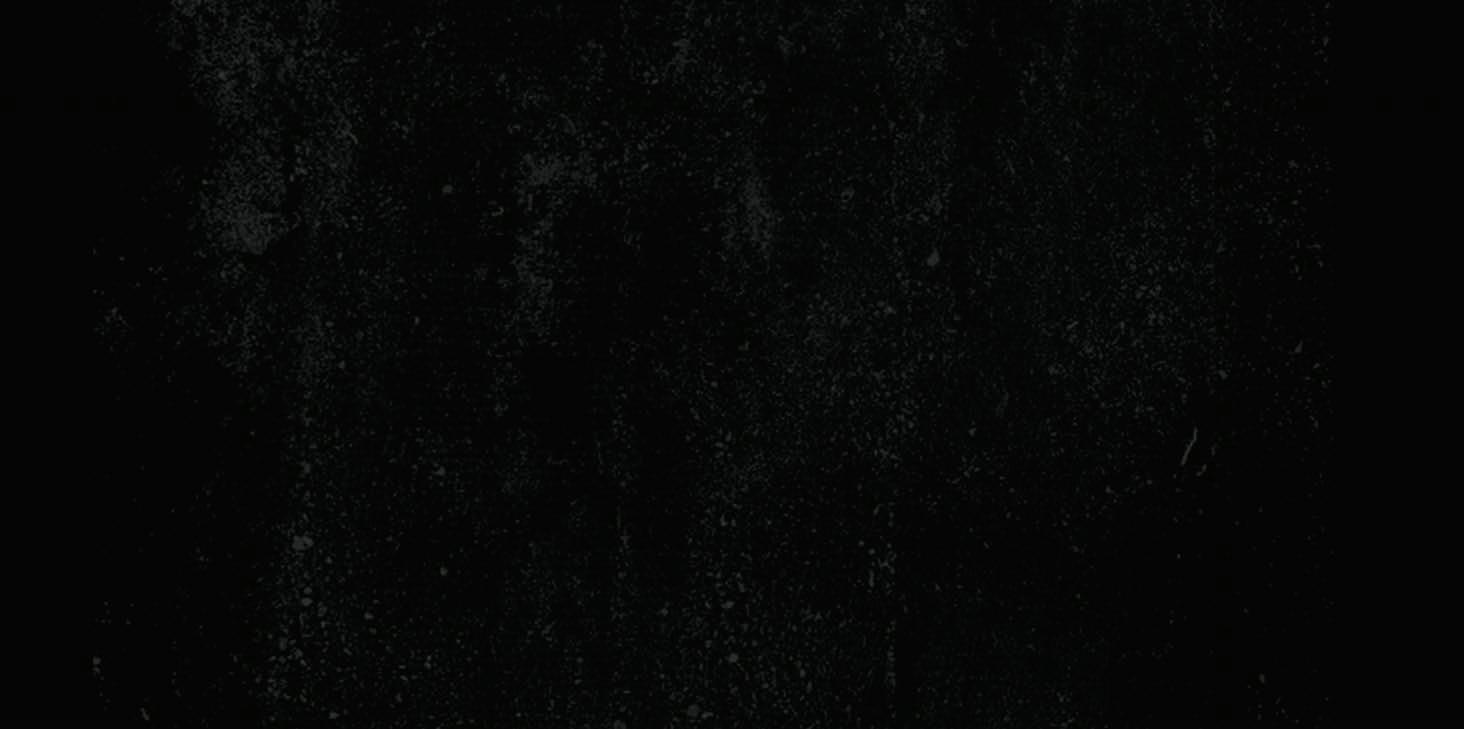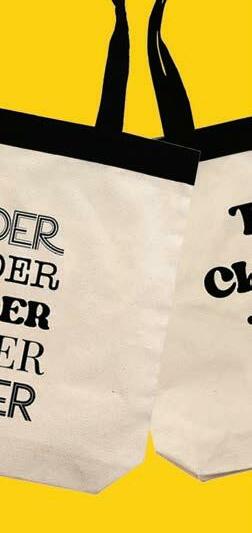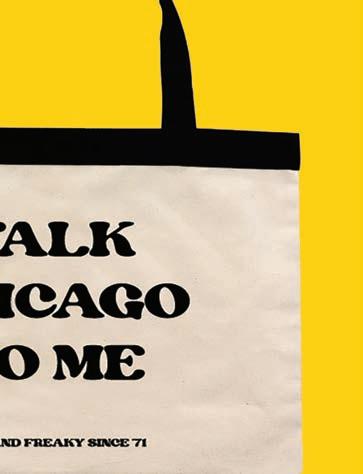Inside the fight for racial equity at SAIC





 By KERRY CARDOZA | 10
By KERRY CARDOZA | 10









 By KERRY CARDOZA | 10
By KERRY CARDOZA | 10



10 Education Current and former students, staff, and faculty at SAIC describe microaggressions, discrimination, and a failed antiracism campaign.
the Reader reviews current releases by Sonny Falls, DJ Corey, Viagra Boys, Old Growth, Steve Earle, and more.

32 Early Warnings Rescheduled concerts and other updated listings
32 Gossip Wolf Chicago’s DIY rock scene mourns Running drummer Alejandro Morales.
04 Street View Tuckpointer Noah Frazier enjoys being outside.
05 Feature An unscientific survey of the city’s matzo ball soup options
24 Wellen | Small Screen Why is everyone horny for Bridgerton?

25 Movies of note Herself is a relentlessly hopeful film, Pieces of a Woman is a shallow depiction of female grief, and Soul is a triumph of animation.
07 Joravsky | Politics Mayor Lightfoot hires an investigator to tell her what she already knows.

08 Isaacs | Culture The Late Nite nuns will rise again.
16 Art ChiByDesign founder Chris Rudd wants to dismantle racism in the design industry.
19 Visual Art More Postcards Please is an interactive time capsule for our moment.
20 Lit Poet Damian Rogers explores her relationship with her mother in her new memoir.

22 New Voices Pegasus’s Young Playwrights Festival enters its 34th year.
23 Virtual Sketch Show Hit ‘Em on the Blackside finds the funny for COVID times.
THIS WEEK ON CHICAGOREADER.COM
26 Collo-Julin | Feature In 1971 the Reader’s free classifieds hosted a future folk star.

28 Records of Note A pandemic can’t stop the music, and this week
34 Savage Love Dan Savage offers advice to parents whose teenager is killing their freaky sex life.
35 Jobs
35 Apartments & Spaces
35 Marketplace
It’s
Three generations of unapologetic Latina activists continue the Lozano family legacy.
A music poll to start 2021
I’m afraid your only choices are Jesu’s “Old Year” and Codeine’s “New Year’s.”
Ma Rainey’s Black Bottom shows how Black folks navigate the power struggles that white structures create.
TO CONTACT ANY READER EMPLOYEE, E-MAIL: (FIRST INITIAL)(LAST NAME) @CHICAGOREADER.COM
PUBLISHER AND PRESIDENT TRACY BAIM
PUBLISHER AND EDITOR IN CHIEF KAREN HAWKINS
EDITOR IN CHIEF SUJAY KUMAR
CREATIVE LEAD RACHEL HAWLEY
GRAPHIC DESIGNER AMBER HUFF
MUSIC EDITOR PHILIP MONTORO
THEATER AND DANCE EDITOR KERRY REID
CULTURE EDITOR BRIANNA WELLEN
ASSOCIATE EDITOR JAMIE LUDWIG
SENIOR WRITERS MAYA DUKMASOVA, LEOR GALIL, DEANNA ISAACS, BEN JORAVSKY, MIKE SULA
EDITORIAL ASSOCIATE S. NICOLE LANE
PRODUCTION MANAGER KIRK WILLIAMSON
LISTINGS COORDINATOR SALEM COLLO-JULIN SOCIAL JUSTICE REPORTING

FELLOW ADAM M. RHODES CONTRIBUTORS ED BLAIR, NOAH BERLATSKY, LUCA CIMARUSTI, MARISSA DE LA CERDA, MARI COHEN, NINA LI COOMES, JOSH FLANDERS, SHERI FLANDERS, JACK HELBIG, IRENE HSAIO, BECCA JAMES, CATALINA MARIA JOHNSON, MONICA KENDRICK, STEVE KRAKOW, NOËLLE D. LILLEY, ASHLEY LUKASIK, MAX MALLER, ADAM MULLINS-KHATIB, J.R. NELSON, JEFF NICHOLS, MARISSA OBERLANDER, ARIEL PARRELLAAURELI, KATHLEEN SACHS, CATEY SULLIVAN
DIRECTOR OF DIGITAL JOHN DUNLEVY SOCIAL MEDIA COORDINATOR JANAYA GREENE
STAFF AND SPECIAL PROJECTS ASSISTANT TARYN ALLEN
STRATEGIC INNOVATION DIRECTOR MARIAH NEUROTH DEVELOPMENT DIRECTOR COLETTE WILLARD MEDIA PARTNERSHIPS COORDINATOR YAZMIN DOMINGUEZ
EXECUTIVE ASSISTANT SANDRA L. KLEIN MEDIA PARTNERSHIPS AND DEVELOPMENT ADVISOR ABHIMANYU CHANDRA
SPECIAL EVENTS CONSULTANT KRISTEN KAZA
ADVERTISING
312-392-2970, ADS@CHICAGOREADER.COM
CLASSIFIEDS: CLASSIFIED-ADS@CHICAGOREADER.COM

VICE PRESIDENT OF SALES AMY MATHENY SALES DIRECTOR AMBER NETTLES CLIENT RELATIONSHIP MANAGER TED PIEKARZ SENIOR ACCOUNT REPRESENTATIVES LENI MANAA-HOPPENWORTH, LISA SOLOMON
CLASSIFIED SALES MANAGER WILL ROGERS
NATIONAL ADVERTISING
VOICE MEDIA GROUP 1-888-278-9866 VMGADVERTISING.COM
JOE LARKIN AND SUE BELAIR
DISTRIBUTION CONCERNS distributionissues@chicagoreader.com 312-392-2970


CHICAGO READER L3C BOARD PRESIDENT DOROTHY R. LEAVELL TREASURER EILEEN RHODES
AT-LARGE SLADJANA VUCKOVIC
CONSULTANT CAROL E. BELL
THE 501C3 FISCAL SPONSOR FOR THE CHICAGO READER IS THE OAK PARK-RIVER FOREST COMMUNITY FOUNDATION.
READER (ISSN 1096-6919) IS PUBLISHED BIWEEKLY BY CHICAGO READER L3C 2930 S. MICHIGAN, SUITE 102 CHICAGO, IL 60616 312-392-2934, CHICAGOREADER.COM
COPYRIGHT © 2021 CHICAGO READER
Featured



$2,890,000

Has the reality of Illinois’ first year of legal recreational pot lived up to it’s promise of equity?


On June 25, 2019, Governor J.B. Pritzker signed a bill legalizing recreational marijuana in Illinois. The bill gave vendor licensing preference to minority owners and made hundreds of thousands of people eligible to have criminal records related to marijuana possession expunged.





















Join us Illinois State Representative La Shawn K. Ford joins WBEZ to examine where the state stands now and how far it has le to go in ensuring equity. Bring your questions about growing and vendor licensing, expungement and what the first year of legal recreational cannabis revealed.


Wed. January 27 | Virtual Event | 6pm Register at WBEZ.org/events

$985,000 Modern





“I’m still getting used to the cold,” says Noah Frazier, 25, a masonry restoration worker who spent most of his life in India and Singapore. Despite loving the outdoors, the Bridgeport resident—who moved from Berlin five years ago—does his best to avoid feeling chilly. “My German grandfather had this saying, ‘There’s no such thing as bad weather, just pointless clothing,’” he says, first in German, then in English. “Even though it’s like 50 degrees today, I put on my thermals and my big coat because I figure you can always shed a layer.” Frazier didn’t spend much money on his outfit, but he decided to splurge on his Timberland boots: “Each of them has one kilogram of insulation, and a safety toe.” Frazier’s coat was thrifted and his overalls and alpaca mittens were given by friends. His face mask was gifted by Jenny Stadler, one of the owners of Wol ait boutique in Logan Square. “I’ve tried a bunch of face masks and this is by far the most comfortable,” he says. “It fits so snug around my face. You can just drop it if you wanna sip your tea or beer, and then put it back up, no problem. The ones that go around
the ear dangle around and fall o .”
Practicality is key in Frazier’s wardrobe, because he spends most of his free time volunteering in community gardens, urban farms, and other nature stewardship projects. Amongst them he cites El Jardin de las Mariposas in Pilsen, Bridgeport Victory Gardens and Plowshares in Bridgeport, Chicago Patchwork Farms, City Farm, Chicago Honey Co-op, and TreeKeepers—a tree planting program provided by Openlands. The day he was photographed, Frazier was planting garlic at El Paseo Community Garden in Pilsen, mulching with the discarded straw he picked up from restaurants and storefronts. He’s been volunteering there for about four years—doing building and repairing projects, beekeeping, and growing plants. “I like improvising and problem-solving, seeing things grow, and using my hands,” he says. “I can’t imagine spending my free time doing anything else.”
More info about El Paseo Community Garden and its expansion at elpaseogarden.org.

Passover isn’t until March, which is when discussion of the infinite depths of matzo ball soup always tend to heat up. So it seems a little early to turn much attention to the pairing of fat-bound matzo meal kneidlach and schmaltzy chicken broth, but matzo ball soup seems to be having a moment with the recent opening of three modern delis each with its own interpretations.
But it wouldn’t be right to address these arguably brash upstarts without first acknowledging the old guard. The matzo ball soup at Manny’s is likely the oldest continu-

ously served mbs recipe in the city. “We don’t like to change things,” says owner Dan Raskin, who says the 78-year-old deli sells about 300 balls a day, depending on the time of year. At $4.95 a bowl it adheres to the most common expectations of something bubbe might put in front of you: two dense sinkers wallowing in a vivid yellow chicken stock with a surface pearlescent with schmaltz, salty as hell, but imbued with poultritude. And there’s body to this broth beyond just the fat. When chilled it almost—but not quite—becomes jellied, indicating a good measure of bony collagen.
If Manny’s sets a standard for the way chicken should impart both flavor and texture to soup, Skokie’s 61-year-old Kaufman’s is a surprising disappointment. Two nicely flu y floaters in a $7.50 quart are done no favors by a thin, dishwater-colored broth that tastes of little but salt. Lots of great stuff at this beloved bakery-deli—just not the soup.
Among the old-timers, Edgewater’s JB’s Deli, housed inside owner Jeff Bendix’s drugstore, is a bit of an oddball itself, but its pale yellow soup base flecked with herbal material and bobbing with thick carrot coins is a happy medium between Manny’s saline intensity and Kaufman’s drab austerity. Its ball, submerged in a $5.59 bowl, is among the densest.
Ursula Siker’s Je & Judes was among the most exciting openings last year, period. It’s a Humboldt Park tribute to her native LA’s deli culture, and the mbs itself is in homage to her grandfather, “a known di cult diner originally from Long Island who would send it back if the matzo ball wasn’t big enough.”
Her rigor is admirable: “Our matzo ball recipe was originally derived from The 2nd Ave Deli Cookbook,” she wrote to me. “We immer-

sion-blend eggs and schmaltz together until super light and flu y, then add in baking powder, matzo meal, and a blend of spices, and combine. Let rest covered for around 20-30 minutes, and then portion and shape using wet hands (not too loose, not too tight, or else you run the risk of them exploding in the water or never cooking through). The cook is a bit fi nicky—you gotta drop the balls into a strong boil and then reduce to a simmer, flipping halfway through, for 15-20 minutes, and of course, we must always sacrifi ce a matzo ball to make sure they are being cooked all the way through.
“I know there’s a lot of debate on what goes into matzo ball soup—just broth, or maybe veg, chicken, noodles, one big ball or lots of little guys, how you cut the carrots. The list goes on. Depending who you ask you’ll get any combination of the aforementioned, and they will tell you theirs is standard and everything else sacrilege. So here is the true standard, of which anything else is sacrilege: one large matzo ball sitting in chicken broth, with shredded chicken and carrot coins. No garnish, and absolutely no celery.”
However, this is not a minimalist J
What indulgence to have hobbies instead of battles
What reverence for name to be mouthful not bite-size chunks gummed gristle
What satisfaction to chew “what if” without bitter aftertaste
What liberation to be bold in moonlight not shrink from slinking indigo shadows
What license to know body as fortress not forfeit or barter
What simplicity to be more than a name to settle into draping arms grow into your sagging belly smile stretched across the constellation of your teeth
What immunity to meet fear the moment heart stops and not its reverse to find respite only in rest
What ease to grow old then forgetful instead of remembered as potential
What contentment to deteriorate watch the next generation outpace you outgrow you students teach you instead of saying your name
What luxury to be wrong instead of dead
What freedom to ask yourself how you want to be remembered instead of becoming activist in death instead of becoming martyr with last breath
What joy to be remembered for what you say in life instead of your last words
& Judes’s offering is an homage to the owner’s
continued from 5
broth. Siker roasts her chicken bones and simmers them for 12 to 16 hours with carrot, celery, onion, garlic, dill, and parsley. She thinks it yields an almost “green” stock, but I think those toasty bones give it an amber depthlessness, nicely balanced, deeply chickeny, and not nearly as dependent on salt as the other contestants.
The most astonishing soup in this lineup is from the South Loop’s Rye Deli & Drink, and I’m a little surprised that Austin, Texas, native Billy Caruso’s “seasonal” soup hasn’t sparked more controversy. The current version’s tennis ball-sized dumplings are made with a mix of blue corn and matzo meal, while the soup itself is more of a stew, thick with shredded chicken and aggressively seasoned with cumin, zaatar, and dill. It comes with printed instructions detailing at-home application of an herb salad garnish with a riot of thinly-sliced, neon-bright beets and radishes that transform any leftovers into a royal
purple borscht. It’s ridiculously delicious, but I could see purists rebelling against this assertively che y expression. (Does anyone’s bubbe work from a five-page recipe?)
Both Siker and Caruso’s soups remind me of the great mbs at the late Frunchroom in Portage Park, and how an ambitious chef can take regular old granny food to another level. But if you think those are weird, get a load of Uptown’s newish vegan deli Sam & Gertie’s (from the owners of the vegan diner Kalish), which will introduce an all plant-based mbs to its menu this month. At presstime Andy Kalish had yet to provide any intel on how he’ll pull this o , but I’m certainly curious.

Finally, I wasn’t a huge fan of the giant sinker served at Steingold’s but if all of this innovation makes you nervous, you can turn to it for reliable comfort when it reopens at its new Lakeview location early next month.
@MikeSulaPoem curated by Nikki Patin: Featured in The Guardian, Chicago Tribune, HBO’s Def Poetry Jam and on international television and radio, writer, producer, designer and survivor Nikki Patin has been advocating, performing and educating for 20 years. She has performed at the National Black Theater in Harlem, Brooklyn Museum, the Goodman Theater, EXPO Chicago and many other spaces throughout the US, New Zealand and Australia. Nikki Patin holds an MFA in Creative Non-Fiction from the University of Southern Maine. Patin is the Community Engagement Director for the Chicago Alliance Against Sexual Exploitation and the founder and Executive Producer of Surviving the Mic, a survivor-led organization that crafts brave and affirming space for survivors of sexual trauma. Her work can be found at nikkipatin.com.






Open Door Reading Series: Chia-Lun Chang, E’mon Lauren, Nilah Foster & Emily Brandt
Highlighting Chicago’s outstanding writers
Tuesday, January 12, 2021, 7:00 PM
Celebrating the Poets of Forms & Features
Celebrate the poet participants in the longrunning Forms & Features workshop series
Thursday, January 21, 2021, 6:00 PM
Have no fear, Chicago.
As I retreated deeper into my annual Christmas/New Year’s hibernation— bingeing on old movies till dawn—I was still keeping track of which of your o cials were naughty and which were nice.
Now I’m doling out my coveted award for outrageous behavior by a local official who thought they could get away with anything on the grounds that it’s Christmas and no one’s paying attention.
No, the award isn’t going to CPS officials who keep saying they know what they’re doing in reopening the schools in the middle of a pandemic— so shut up, teachers, and get in those classrooms!
Even though they still haven’t notified the pregnant teacher I wrote about weeks ago whether she’s exempt for health reasons. If it was up to CPS, they’d make her have her baby under a classroom desk.
It’s a local award, so I can’t give it to President Donnie, though calling elected o cials in Georgia to get them to throw out Biden votes is pretty outrageous.
So, you could make a strong case that the award should go to Tribune editorial writers and other cowardly Republicans who have so much to say about Speaker Madigan but are too chicken to criticize Trump.
No, the award goes to Mayor Lori Lightfoot for her handling of the police raid on Anjanette Young’s house. Specifically, her December 22 announcement that she was bringing in a special investigator to essentially investigate what she knew and when she knew it.

As if Lightfoot couldn’t just answer both questions on her own right now—without a special investigator.
Slick move, Madame Mayor. Somewhere Mayor Rahm’s going—Man, why didn’t I think of that with the Laquan McDonald video?
To refresh your memory, the Anjanette Young case went down like this . . .
In February of 2019, about a dozen police officers waving a no-knock warrant kicked open the door to Young’s house to discover her naked and alone.
They handcuffed her and ransacked her home, looking for someone and something that wasn’t there. ’Cause they had raided the wrong house.
Which is what Young, a social worker, was trying to tell them. Though they wouldn’t listen. ’Cause it said on their little piece of paper that it was her house. And if it said it on their little piece of paper, it can’t be wrong.
And you wonder why teachers don’t trust the system to get things right.
The raid, as Mayor Lightfoot loves to remind people, occurred several months before she was sworn in as mayor and vowing to “bring in the light.”
But for almost two years, city lawyers from Lightfoot’s administration have been in court battling Young, fighting like hell to keep video of the raid a secret and treating Young like she did something wrong for demanding that the city try to make things right.
So as much as I’m tempted to blame most bad things on Rahm, in this case he’s largely blame free.
Young’s lawyer leaked the video to reporter Dave Savini of CBS 2. Prompting Mayor Lightfoot to release the following statement on December 15—a statement that will live on in infamy—after Savini ran a story.
“Today, I became aware of an incident involving Ms. Anjanette Young from February 2019, before I became mayor, and I saw a video today for the first time. I had no knowledge of either until today. I had a very emotional reaction to what was depicted on the video as I imagine that many people did.
. . . Since this matter is the subject of litigation and an open COPA investigation, I will have no further comment.”
Soon thereafter the proverbial shit hit the proverbial fan as more and more people saw the video.
And Mayor Lightfoot did a quick 180. Out the window went her whole “I-can’t-talkabout-the-case-’cause-it’s-in-litigation” spiel. And she hasn’t stopped talking about it since.
Apparently, she fi gured out that the more she talks about the raid, the less people will remember that she was the one playing hardball with Young in the first place.
She’s apologized. She’s met with Young. She’s released e-mails that showed she had, in fact, been notifi ed about the matter months before Savini aired his report. So it looks like she wasn’t being exactly truthful in her infamous December 15 statement.
And she got Mark Flessner—her corporation counsel—to resign.
The corporation counsel is the lawyer who sits next to the mayor at City Council meetings and whispers things into her ear and laughs at the wisecracks she whispers back.
You know, I think I could handle that job— and I didn’t even go to law school.
As an employee of the city, the corporation counsel is supposed to live in Chicago. Only Flessner lives in Naperville.
When the Naperville story broke, my fi rst thought was—there’s dozens of lawyers who practice in Chicago, couldn’t Lightfoot find one who actually lives here?
But Lightfoot insisted Flessner was so brilliant only he was capable of the job. And now, just like that, she’s treating him like CPS treats its teachers—beat it, buster!
The whole thing reminds people of how Rahm handled the Laquan McDonald video. Like Lightfoot, Rahm said he didn’t see the video until it was released to the public.
Rahm also found a convenient scapegoat to blame, fi ring then police chief Garry “Big Mac” McCarthy.
Big Mac got so mad that he ran against Rahm before Rahm bowed out of the 2019 race. If this pattern holds, look for Flessner to run against Lightfoot in 2023. Though residency rules might be an issue.
Lightfoot’s investigator is former federal judge Ann Claire Williams, now a partner for Jones Day—President Trump’s election law firm (for more on Jones Day, read Elie Mystal’s column in the Nation).

What is it about Lightfoot and her lawyers?
First she hires a guy who lives in Naperville. Then she hires one from a firm that represented Trump.
Whatever—come get your trophy, Madame Mayor. The inscription reads: If at fi rst you tell the truth, you’ll never have to hire an investigator to explain why you changed your story. v
In the meantime, Vicki Quade has a new Chicago book.
By DEANNA ISAACSVicki Quade had a new show opening at the Royal George Theatre the weekend of March 15, 2020. Quade, coauthor and producer of the long-running comedy show Late Nite Catechism , was appearing herself in some performances of this new spin-off, Easter Bunny Bingo, as former nun Mrs. Mary Margaret O’Brien. The show played for just two performances before it was shut down by COVID.
For the first time in nearly three decades, the Late Nite nuns have been shut up. If you’re in danger of disappointing Jesus, they’re not around to tell you.

“Sunday was the press opening. We did have a decent audience,” Quade says, “but there were a lot of cancellations because people were afraid. The pandemic was clearly a reality at that point. We cleaned up after the show, looked around and, as we walked out, thought, ‘We’re not going to be here next week.’”
Easter Bunny Bingo had been filmed that first weekend, however, and Quade was able to “pivot,” getting it online for streaming during the Easter season. “But streaming was pretty new at that point,” she says; the audience wasn’t really there yet. By summer, when
she launched an archival series (starting with Christmas Bingo, Summer Edition), there was more interest. Despite the lack of the live audience participation that’s worked so well for these shows, she says the streaming’s chugged along since.
Otherwise, like almost the entire Chicago theater community, the nuns have been sidelined—interrupting a nearly 28-year Chicago run for the original show. Late Nite Catechism launched in 1993 at Live Bait Theater, spawned productions all over the country (among them, a seven-year o -Broadway run), and survived some nasty court battles among its creators, including coauthor Maripat Donovan. After a nomadic start, moving from Live Bait to the Organic, Zebra Crossing, and the Ivanhoe, the Chicago production’s been at home in the Royal George for the last 20 years. Quade hopes they’ll be back there, even if distanced and masked, as soon as next fall.
In the meantime, she’s authored a book: Close Encounters of a Chicago Kind, published last month by Eckhartz Press. Quade (who started out as a journalist and was a Reader contributor) has been posting brief stories
on Facebook for about ten years. She met Eckhartz’s owners, Rick Kaempfer and David Stern, in February, when they interviewed her about the Easter Bunny show for a podcast they also hosted. It occurred to her to ask if they’d be interested in a book that would be a selection of these posts. They were.
The result is a brisk walk with Quade through daily life in Chicago, presented in bite-size chunks addictive as a sack of Garrett popcorn. We’re on her arm as she perambulates (or drives), often around the north side—think Reza’s, Dinkel’s, the Dunkin’ Donuts at Wilson and Broadway—without letting the driver who calls her a “stupid bitch” or the “low life” who steals her cane out of a grocery cart when she turns her back at the Jewel cramp her style.
She also takes us into the theater, where she deals with audience members who turn surly, and hands out Infant of Prague cards as a combination bingo prize and fertility charm. The major encounter, of course, is with Quade herself, a shameless people watcher, celebrant of the small moment, and exposer of the selfish and willfully ignorant.
On the other hand, if you’re a kid who’s zipping a gun into your backpack but dreaming of being on stage, or—like the couple she watched score a free meal at Manny’s—either totally hapless or a very talented scammer, she’s fascinated.
Quade’s planning to adapt some of these stories for the theater after live performances resume, possibly as soon as Labor Day, “if enough people get vaccinated; my arm is ready.”
After dispensing the only financial assistance she’s received so far—a grant that allowed her to pay employees into May—she had to furlough stage managers, actors, and office help. But she expects to survive the shutdown because, unlike many of the midsize theaters she worries about, she doesn’t own her performance space and also hasn’t had to pay rent while the shows are closed.
She says she can see now that the random vignettes in her book are all about coming in touch with people: “I didn’t plan it this way, but it points out what we’ve been missing this past year, which is the ability to go out and witness something, meet someone, talk to people on the sidewalk.”
@DeannaIsaacs




At Rise, you’re always welcomed just as you are, there's no such thing as a silly question and you have access to all the best cannabis products for your well-being.


Current and former students, staff, and faculty at the top-ranked art school describe microaggressions, discrimination, and the administration’s failed anti-racism campaign.
 By KERRY CARDOZA
By KERRY CARDOZA
“I’m Sorry.” That was the subject line of a university-wide e-mail sent by School of the Art Institute of Chicago provost Martin Berger, an e-mail that many had waited almost two years for. In September 2018, as the newly hired dean of faculty, Berger presented his work studying photography and the civil rights movement to a room of hundreds of faculty and staff, including some security and food service workers. Berger is tall and well-manicured, with a bald head and light blue eyes. One faculty member described him as so anxious he was hard to be around. In sta meetings held on Zoom and uploaded to YouTube, he speaks methodically and with little emotion, wellversed at giving pro forma answers that don’t reveal too much. Berger did not respond to requests for comment for this story.
The mood at the meeting, which had an open bar and gave employees across the school a rare opportunity to get together, was festive. During his talk, Berger quoted the Black activist Elizabeth Eckford, one of the Little Rock Nine, the fi rst Black students to integrate an all-white Arkansas high school, using the N-word. It sent shock waves through the room. Berger would later apologize individually to those who complained about his choice of words, though for months he defended his usage on the grounds of academic freedom. In an interview, he explained that he used Eckford’s own words “in an e ort to return agency to the young black activist” and “to illuminate her actions and thoughts.” It’s apparent that
he didn’t grasp the gravity of the situation, that he didn’t expect his actions to have ripple e ects.
“Recent conversations with the incoming and outgoing members of Student Government and Graduate Senate convinced me of the need to send an apology to students for my September 2018 talk,” he wrote in his e-mail this June. “It should have come much sooner.”
The debate around free speech on college campuses is of course nothing new. And if this had been an isolated incident, perhaps what happened at one of the nation’s topranked art schools might not have reverbated as long and as far as it did. But just six months after the lecture in question, with unheeded calls by faculty to have an open forum, Berger was promoted to provost after an opaque hiring process.
This sequence of events, involving an act of harm committed on members of the school’s community that was inadequately addressed, and a lack of transparency, accountability, and communication around school policy, illustrates what many consider the status quo at SAIC. I spoke to over a dozen current and former students, staff, and faculty who described a toxic atmosphere for BIPOC, replete with microaggressions or outright discrimination, where complaints are dealt with individually, rather than systemically, if they are dealt with at all. Like many other institutions in the art world, this year SAIC has pledged to address systemic racism on its campus, with a newly formed anti-racism committee, among other
initiatives. But with Berger, an increasingly problematic fi gure, as one of the most powerful people at the school, and above him President Elissa Tenny, who has also fielded calls to resign this year, many wonder if real change is possible.
On March 12, President Tenny announced that spring break would be extended due to the rapidly worsening coronavirus pandemic. Students initially expected to be back in a few weeks, but the downtown Chicago campus largely shut down and classes went remote for the rest of the semester. While that shift might be abrupt for any school, for art students without access to studios or to vast facilities, the ability to complete certain assignments was completely cut o . Students in designed objects or sculpture were suddenly without access to the woodshop and other fabrication equipment; ceramics students went without pottery wheels or kilns; photography students had no editing workstations and no access to scanners, the darkroom, or the school’s print services.
Tenny, SAIC’s fi rst female president, is in her late 60s, with shoulder-length, hay-colored hair and bangs that frame her face. She’s prone to wearing eclectic jewelry, the kind you’d fi nd in a museum gift shop. Many community members I spoke to described Tenny as out of touch or ineffective. In a meeting posted on YouTube, she stumbles over her words, and cracks a smile when addressing staff concerns that e-mails are being monitored. At another point, she says, “I know we’ve all read articles about how challenging it has been for people working from home raising kids,” as if this isn’t a reality for many of her actual employees. Tenny did not respond to requests for comment.
On April 20, the Black Student Union (later renamed Blk @ SAIC) published a set of demands for the administration asking for universal credit for the semester, continued pay for all employees, and new sustainable practices regarding accountability and fi nancial stability. The organizers also released a survey to the SAIC community, asking what resources folks needed and if they had safety concerns. After just five days, the survey received more than 500 signatures and almost 200 people shared testimonials.
“We pay to go to the school to have access to facilities and studio space and we may not all have that at home,” says Hayley Bain, one of the current leaders of Blk @ SAIC, who I spoke to over Zoom. Bain, who wears glamorously oversized tortoise-shell glasses
and a septum ring, is in her fourth year and primarily makes works on paper. “So to act as if we all do is very presumptuous. Even for academic classes as well, home is a di erent space for everybody. So completing academic work is going to look di erent.”
Just days before the extended spring break began, FNewsmagazine, the school’s newspaper, published a story with the headline “When the Dean Said a Slur, And Then Got Promoted,” detailing Berger’s use of the N-word and subsequent promotion. While faculty was already aware that this had happened, the article ensured that now everyone at SAIC was. Perhaps the story wouldn’t have had much of an impact, with everyone isolated at home with the pandemic to worry about. But the resurgence of the Black Lives Matter movement in late May, and SAIC’s participation in Blackout Tuesday on Instagram, a social media campaign meant to serve as a day of reflection following George Floyd’s murder, helped resurface the incident.
On June 10, Tenny sent out a statement detailing the school’s renewed commitment to anti-racism. “While the world is gripped with a fervor to recognize and take decisive action against systemic racism, we cannot fail to act as an institution,” she wrote. She outlined the steps the institution would take, including the establishment of an emergency relief fund for students, the formation of an anti-racism committee, a day of mourning for all sta , a $25,000 donation to be split among seven nonprofits in North Lawndale, and continued “e orts to build diverse hiring pools for positions throughout the institution, especially among full-time, tenure-track faculty.” Another paragraph detailed the continuation of initiatives that support the Black and Brown members of campus, such as scholarships for Chicago Public Schools students, programming in North Lawndale, and grants which support diverse campus projects and curricula. Many students, staff, and faculty felt that these e orts were far from enough.
In an open letter to Tenny published in FNews on June 9, junior Sherman White called the president’s statement “not revolutionary, but reactionary.” “You have a chance to prove yourself a true ally,” White wrote. “It is not enough to not be racist. You must be anti-racist .” White called on the president to condemn the Chicago Police Department, to publicly reprimand Berger, and to cease using Black students’ artwork as a prop of solidarity. (Alum Charly Palmer’s recent Time magazine cover of a Black girl
above a bleeding bunch of roses, a blazing battle scene in her hair, was featured on the university’s website.) As for the $25,000 donation, White pointed out that it amounted to just $3,571 per nonprofit, or “almost $2000 less than it cost to take a course here at SAIC.”
A Change.org petition calling for Berger’s resignation was published just a few days later. “Berger continues to use, and defend his use of, the n-word,” the petition stated. “In the spirit of justice we believe the provost position should be fi lled by a BIPOC.” To date, it has garnered more than 2,500 signatures. Dozens of signatories left comments showing their disgust and disillusion with the school. “Inexcusable. Resign,” wrote one commenter. “This school has yet to do much of anything for their students of color,” wrote another.
Tenny’s disconnect with the realities of BIPOC members of the campus was also made apparent through her announcement of the passing of Lynika Strozier. Strozier, a Black woman, died of complications from coronavirus in June. She was 35. Strozier worked part-time at SAIC as coordinator for the Science and Bio Art Labs and was also an adjunct professor at Malcolm X College. Tenny initially sent out a notification of Strozier’s passing only to faculty and sta , which the school says is standard practice. Weeks later she sent out a second e-mail, including students, acknowledging that “our practice of notifying only faculty and sta of sta members’ deaths has not been followed consistently, understandably upsetting a number of students.”
Tenny also acknowledged that the e-mail raised concerns because Strozier’s death was COVID-19-related, which has disproportionately impacted people of color. “Our feelings of grief over the impact of this terrible pandemic and anger that systemic racism make[s] some of us more vulnerable are real, and those feelings were exacerbated by the poor handling of the message,” she wrote. “The messaging error was unintentional, and I am sorry.” What went unmentioned was Strozier’s lack of health insurance as a part-time sta member. According to the school, only full-time sta members, or those working at least 30 hours per week, are eligible for health insurance. A GoFundMe to help with hospital and funeral expenses has thus far gathered more than $84,000 in donations, including a $500 donation from Tenny. In July, Tenny and Berger announced a new undergraduate scholarship in Strozier’s name.
On June 30, an e-mail went out to all the student workers in the admissions office, letting them know that their hours for the summer had been cut to almost nothing. Undergraduate student Nadia Frierson described the e-mail as tone-deaf; it included a meme of a viral moment from a protest when a woman told a cop, “You about to lose your job.”
“This is a big issue because everybody’s depending on this job to pay their rent,” Frierson tells me over the phone. “We did lose our jobs, basically. Like we’re employed but we’re not getting paid.”
Frierson and colleagues pushed back against the e-mail, and their office held a Zoom call where student workers could air grievances. There were a lot. Many centered around Frances Pleines, who was then the director of undergraduate admissions. Sta and students alike reported that Pleines engaged in racial profi ling and discrimination of students, making comments like “Mexicans are very hard working and therefore good employees” or that “female Indian student workers were ‘lazy.’” Pleines would reportedly handpick students of color to participate in photo shoots for admissions marketing materials. She was known to misgender transgender students and alumni, often referring to them by their dead names. There were dozens of other complaints, detailing a pattern of psychological harassment, pitting students and staff against one another, and inappropriately sharing personal information, among other workplace abuses. It wasn’t until sta were able to work remotely, out of earshot of Pleines and other authority fi gures on campus whom they feared retaliation from, that they realized others were having the same negative experiences. Pleines declined to comment on these allegations.
These grievances, obtained by the Reader, were collected and sent to the vice president of enrollment. Pleines left the school over the summer, though the Reader couldn’t confi rm if she was fi red. Sta and students, however, say that Rose Milkowski, the vice president of enrollment management, and Asia Mitchell, the executive director of undergraduate admissions, were at least partially aware of Pleines’s behavior, and fi elded their own complaints. (Milkowski and Mitchell did not comment on these allegations.)
After the admissions o ce Zoom call, the student workers met with other students and staff and decided to do more campus-wide organizing. Dismantle SAIC, also known as SAIC Solidarity, was formed. Currently
continued from 11
made up of Frierson and fellow undergraduates Nicholas Zepeda and Jonathan Swain, Dismantle SAIC released their own Google survey, asking SAIC students, sta , contracted workers, and alumni whether they faced discrimination at the school. Almost 300 people submitted responses: 44 percent of respondents said they’d been discriminated against, with another 31 percent not sure if their treatment could be categorized that way. Many respondents described painful experiences with the upper administration, mishandled sexual assault cases, racist course material, misgendering by professors, a refusal to be given proper disability accommodations, and a general lack of support for BIPOC students. Even more responses were sent through e-mail or Instagram DM.
At the end of June, Dismantle SAIC wrote a comprehensive, 13-page letter to Tenny, Milkowski, and then-interim dean of faculty Je erson Pinder demanding action. (Pinder, who is Black, has since been made director of academic a airs for diversity, equity, and inclusion. He also heads the new anti-racism committee, which reports to Tenny.) According to FNews, seven admissions sta ers who signed a letter in support of SAIC Solidarity were let go over the summer. Dismantle SAIC enumerated the reasons for concern: the initial silence on Berger’s use of the N-word, his subsequent promotion, the petition calling for his resignation, and his belated apology; the layo s of sta at the Art Institute after calling for more transparency around downsizing and plans to reopen the museum; an incident reported in the Sun-Times in which a former student was allegedly subjected to sex discrimination and physical abuse by then-faculty member John Phillips (according to a lawsuit fi led by the student, Phillips was fired in 2016), the student’s direct adviser; and missteps by Tenny regarding her announcement of the death of Strozier.
The demands fall into four broad categories: more accountability in the admissions office; reform to the curriculum, including decentering whiteness and white art; hiring more faculty of color; and providing more financial and institutional support to students. “SAIC is a non-profi t institution and should prioritize their commitment to the public good and its students over for-profi t business practices,” the letter states. In my conversations with current and former students, faculty, and sta , many pointed to the school’s prioritization of profit over academic scholarship and student well-being.
Several casually mentioned Tenny’s salary; in 2019, her total compensation topped $711,000, which includes a housing stipend of $4,000 per month.
For Dismantle SAIC, Tenny’s financial security directly informs the disconnect between their needs as students and the institution’s inability to adequately address them. After months of meeting with the administration and little progress to show for it, Dismantle calculated their hours and sent a request for compensation. From June 18 to August 23, three of the main student organizers had each worked 362 hours.
“While they did not come into this journey with the intention of being compensated, the exaggerated timeline of this project has presented Frierson, Ivory and Zepeda with extensive mental and physical strain from working with/at the School of the Art Institute of Chicago,” they wrote to Tenny, Milkowski, and Pinder.
According to Frierson, the administration asked how the students would like to be compensated, though payment and tuition adjustments were off the table. Dismantle decided not to respond. A representative from the school counters that the students received a stipend.
Meanwhile, due to work hours being dramatically cut, Frierson lost their housing over the summer. “I think [Tenny]’s one of those white women that really doesn’t understand the magnitude of the situation, that she’s been having a part in actively oppressing people,” Frierson says. Because of Tenny’s secure position, aided by her housing stipend, Frierson felt it was clear that the president was oblivious to the economic realities of her students.
Frierson is a fi fth-year student who works mostly in the fibers department, creating beautiful geometric assemblages with handmade paper. Their admission to the school is deeply personal. Decades ago their father was discouraged from attending SAIC; he was essentially told he’d never make it as a Black architect. Their father and grandmother have both made tremendous financial sacrifices to allow Frierson to attend.
“My ancestors did a lot of work to put me where I’m at so I should appreciate the privilege that I have been able to access thus far,” they said.
Lisa Vinebaum, the chair of the fiber and material studies department, says the compensation of upper administration underscores the lack of progressive vision. In ten years at SAIC, Vinebaum has been a part of many e orts to bring greater equity
to the school. Her work often explores topics of labor justice or how art can play a role in social change. “The question is, what kind of institution do we want to be?” Vinebaum says, noting that the school falls short of its ideals. “We know what kind of school we are. We’re a corporate art school that is trying to present itself as something that is progressive and forward-thinking and aligned with Chicago and trying to make change. But at the end of the day, it’s not.”
According to the school’s 2018 tax returns, the total compensation of Tenny and the other highest-compensated administrators amounted to more than $3.2 million. This doesn’t include ten other VP-level executives. All but one person in the president’s 18-member cabinet are white. The majority of the school’s revenue, 77 percent in fi scal year 2019, comes from tuition and student fees. The cost of one year of undergraduate tuition is $52,000, which doesn’t include any fees or housing expenses. Tuition increases an average of 2-4 percent per year. Though students asked SAIC not to raise tuition this year as much learning continues to take place remotely, the school went ahead with their scheduled increase for all students with the exception of Pell Grant recipients, those with the most fi nancial need, about 22 percent of the student population. It is easy to see student’s frustrations with their institution—they know their money is lining the pockets of the administration, and yet their concerns are consistently overlooked.
On June 11, faculty chair Beth Wright sent an e-mail out to faculty that, like many communiqués from the institution, toes the line between coldly professional and empathic. “It is hard, right now, to be resident in this country. On all sides there is pain: physical, spiritual, economic, mental,” Wright begins. “Is it more important to protect our community by not gathering on campus in any form at the price of precipitous enrollment drops, or by doing all we can to maintain everyone’s livelihoods and health insurance at the cost of possible risk of infection? The choices are hard, and I do not think I can dismiss or blame people who make di erent choices than I do in each case. I would like us to be generous when we disagree about the best way forward for ourselves and our community, remembering that none of us believe cops killing people of color is okay.”
“It was really insensitive,” says one faculty member, noting the very real precariousness of many part-time employees. “Don’t say none of us believe cops killing people of color
is OK. That’s obviously not true. That’s why they keep getting o when they kill people of color.”
By early summer, many other complaints against the school or specific departments were being made publicly. Alum Adreain Jovan Guillory shared a video on Instagram, noting that the fashion department had reached out to him, asking for images of his work as a means of standing with the Black Lives Matter movement. Guillory declined, saying “We’re out here dying, so a post is not really doing anything for me.”
Jax McFarland, a former graduate student in the architecture, interior architecture, and designed objects department, also posted a video to Instagram, detailing some of the racism he experienced in his department, which he eventually discussed with the Title IX o ce and Tenny. She referred McFarland to Berger. “I have to sit down with the guy who uses the N-word who thinks he’s some white savior, that he’s not biased,” McFarland says. After the meeting, Berger waived McFarland’s tuition, while officially determining there was no wrongdoing. “Pretty much what Martin tried to do was silence me by adjusting my financial aid,” McFarland said in the video. A group of sta in the admissions o ce also wrote an open letter in support of the admissions “student ambassadors’ demands that leadership address racism and unethical workplace practices.”
Anna Martine Whitehead, an adjunct professor in the contemporary practices department, began talking and reaching out to other Black faculty members, trying to come up with a plan to support the demands coming from BSU, Dismantle, and other students. These faculty members formed the collective Black Futures to try to synthesize all these grievances and lay out a vision to move forward. When Black Futures first coalesced, Whitehead was struck by how frequently Tenny and Berger tried to handle complaints with private meetings or conversations. Again and again, administrators try to isolate and individualize issues, propose a plan they feel comfortable with, and forego any chance of systemic change. “It uses their work to kind of gather together a group of folks and get names from those groups, and join the committee without actually taking seriously the demands of those groups,” one member of Black Futures says.
Carly Maria Trujillo, an undergraduate student and a co-leader of the Native American Student Association (NASA), worked with Dismantle over the summer to present to Tenny a proposal to rename the school’s
Columbus building, an informal name stemming from its location on Columbus Drive. NASA had proposed renaming the building “Three Fires,” after the Three Fires Confederacy, made up of the Ojibwe, Potawatomi, and Odawa tribes which resided in the Chicagoland area. “Why does a ‘proactive,’ ‘diversity valuing’ institution have a building named after a man who’s [sic] only intentions were driven by greed & the side e ect was genocide?” NASA asked in the proposal.
In an e-mail from Tenny that Dismantle shared on social media, Tenny writes that while she supports renaming the building, “we must do so in fashion that preserves our ability to realize the renaming as a fundraising opportunity.” It was later announced that the building would be referred to as the “280 building” in the interim, named after its street address.
A representative from the school confirmed this, writing in an e-mail that “it’s important to note that colleges, nonprofit organizations, and other institutions throughout the world understand the potential value to its community via scholarships and other funding availability.” Then the response took a more personal turn: “I saw in your bio you went to Northwestern – how many buildings/fields/parks/centers are named after benefactors? Probably any space or facility they could name for a donor where the funding can be used toward a student benefit. I’m saying this not because I have info to share about our naming plans – I don’t – but because I think it’s important to consider in the context of the calls for a name change. If a college’s options are to name a building or a space whatever they want vs. name it after a donor that could provide millions of dollars toward scholarships for those students most in need (thereby allowing scores of students to pursue higher education), why not consider this as an option?”
Camille Ariyana Billie, a third-year student in designed objects who is also a NASA co-leader, doesn’t understand why scholarships for Indigenous students, or hiring of more Indigenous faculty, has to be done through donor money. “I get that it’s symbolic, symbolism matters, especially in a large institution and everybody’s watching. But it’s like, if everybody’s watching and they see that you’re being blatantly anti-racist, shouldn’t that be good?” she asks. “Shouldn’t you not think about money? Shouldn’t you think about the hundreds of years of genocide and systematic oppression that the school does benefit from? They are sitting on the very land that was stolen.”
Berger has since reached out to Trujillo, asking to meet privately with her or NASA.
“I’m very frustrated by the pressure that I’m feeling to do that,” Trujillo says. She’s wary of the experience Dismantle SAIC had: months of emotionally exhausting meetings that ultimately led nowhere. Trujillo was one of just three students to join the anti-racism committee.
Several people reported similar experiences: an apparent willingness of the president, provost, or other administrative
with you. “It’s like, ‘we hear you,’ it’s just a thing people say.” Her Blk @ SAIC co-leader Alisa Drakes agrees. “You hear us but you’re not actually listening.”
Black Futures spent weeks drafting a road map for how they feel the school should move forward in its anti-racism work: things that should happen now, within 30 days, 60 days, one year, and five years. It covers a broad swath of areas, from providing sick leave to contracted staff to arranging dedicated space on campus for BIPOC students to cre-
vate meeting to discuss the concerns. A week later, they sent a more detailed response, offering immediate action on just three items. They then addressed “assumptions that we believe aren’t accurate or easily rectifi ed.” Black Futures responded just once, stating that the administrators’ proposals were inadequate and embodied “the lack of sincere attention we are calling for.”
Vinebaum, who signed on to the Black Futures demands, thinks the administration’s response shows a lack of cultural competency. “The letter from Black faculty reflects so much trauma and pain that school leadership doesn’t seem to understand or want to try and understand, which is textbook white fragility,” she says. “If one is going to be anti-racist genuinely then one should listen to the people that are aggrieved, and not think that they know better, and not be defensive. And it’s really hard to do but that’s essential. That’s the work.”
Black Futures has been very public about their refusal to engage with the administration in an endless back-and-forth. “This doesn’t have to be a conversation,” says a member of the collective, who did not want to be named for fear of retaliation. “It doesn’t have to be a conversation because here’s a road map. This is our conversation, we started it, and there doesn’t need to be any quibbling about what’s happening because there’s just things that need to happen. This quibbling even started without us responding, reacting, which is what happens when Black people say anything 99 percent of the time.”
Savneet Talwar had just become the chair of the art therapy department in the summer of 2019, and was tasked with bringing her department in line with a new, more stringent accreditation process. As a result of the changes, which required more work and a revision of syllabi, two faculty resigned from the department.
figures to listen—in private—but then no action. “I think they really rely on this idea that students will be up and out in two to four years, and so they really center individual appeasement as opposed to systemic change,” Vinebaum says. “Obviously responding to students one-on-one is important but if there’s not going to be systemic change, then you’re going to keep bringing students in and traumatizing them, and faculty as well.”
Hayley Bain, from Blk @ SAIC, says upper administration will never outright disagree
ating pathways for part-time BIPOC faculty to advance into full-time, tenure-track positions. “We are extremely dismayed by the facts of what it has cost—two years of sta , student and faculty labor, fi nancial resources, and an international Black Lives Matter Movement—to create this opening for racial justice at SAIC,” they write. They also call for the resignation of all negligent parties involved in the Berger incident. In all there are 34 action items. The letter has over 300 signatories.
Tenny and Berger initially offered a pri-
In late January 2020, Berger took the former chair Randy Vick to lunch to celebrate his retirement, where Vick reportedly expressed concern over the recent resignations. Berger inquired into how things were going in the department. Talwar later learned that Berger had asked the dean of faculty, Beth Wright, to do exit interviews with all the faculty who had left in the previous year, which included the spring before Talwar was chair. In the middle of this, the school went remote, and, for a time, Talwar thought the investigation would dissipate. But during a phone call with Wright in
The school is in a position where they’re very much concerned with like, how do we look? Do we look like we’re doing a good job? Because doing a good job is difficult work and it takes a lot of difficult decisions, but it’s pretty easy to send out e-mail.”
—Hayley Bain
continued from 13
May, Talwar learned the investigation was completed, and that a report had been given to Berger. (Wright, who has since stepped down as dean of faculty, did not respond to requests for comment.) Berger refused to give Talwar a copy of the report when she asked, but he agreed to a meeting.
Talwar invited Raja Halwani, her faculty liaison, to the meeting with Berger, which took place June 1. In the meeting, Talwar asked Berger what policy allows him to conduct such an investigation on a faculty member. He said that there wasn’t any, and admitted that the investigation did not reveal any discrimination on Talwar’s part.
“I said, ‘So you were looking for that? Because if you were looking for that, nobody has interviewed me to know my side of the story,’” Talwar says. “I said to him, ‘My department is the only department in this institution that is run by two faculty of color. What we consistently face everyday has never been the case for any of my predecessors, who were all white.’”
She says Berger responded by telling her she was “rough around the edges” and in need of mentorship. “I was just shocked,” Talwar says. “This institution takes on an anti-racism stance and this is my interaction with my provost.”
Not trusting the Title IX process at the school, Talwar made a complaint with the Equal Employment Opportunity Commission. The school refused an initial request for mediation. The next step is for EEOC to conduct an investigation. “Whatever is in that document, whatever they did, I know is wrong. And they know that it is wrong as well,” Talwar says. “The institution can keep making the commitments to anti-racism, but when it comes really down to actually having these conversations, nobody is interested. This performativeness has just become old for everyone.”
Cauleen Smith, a former visiting artist, had a similar experience. After a student complained about Smith’s critique of her work, Smith says her one-year contract was prematurely terminated. “It wasn’t that what I said was objectionable or offensive or demeaning, she just didn’t like it,” Smith says. “And the chair, instead of telling her, well that happens, told me that I needed to apologize to the student. I refused.”
Smith then had a meeting with the chair of the fi lm department and Paul Co ey, a vice provost and the current dean of community engagement. “The meeting started, literally with this individual, Paul Coffey, saying to
me, ‘Do you like working here or not?’ That was his fi rst question. ‘Do you want to be a part of SAIC or not?’” she says. From there, the conversation did not improve, and Smith did not teach any further classes. She says they presented her with a contract where she would instead complete research but she ignored it. Neither Co ey nor the fi lm chair at the time responded to repeated requests for comment.
“They routinely treat their faculty like they’re lucky to have a job when in fact it’s the opposite,” she says. “The idea that a provost would begin a meeting by saying, ‘Do you want to be here or not?’ as if there’s some sort of loyalty quotient that I’m supposed to demonstrate, not by showing up to do my job but in other ways. It’s really appalling. And it’s defi nitely part of the culture.”
The frustration that campus members have expressed regarding the school’s inadequate anti-racist actions are understandable, given that many have previously tried to dismantle the institution’s structural racism. In 2009, SAIC created a strategic plan intended to build diversity, including several e orts to encourage diverse students to apply or transfer to the school. In 2013-14, the school established yet another committee “to further diversity, equity, and inclusion efforts.” In 2016, a symposium was held on campus on decolonizing art education. Feedback was shared with Tenny and then-provost Craig Barton, and touched on many of the same issues being brought up today: participants cited the inherent white supremacism of the school, the way it appropriates student actions and labor, and a need for more diverse students and faculty.
In a statement on their anti-racist e orts, a school representative wrote in an e-mail: “We’re energized by the community’s passion for this work and the progress that has been made. We know there is much more work to be done, and there may be missteps along the way, but as a higher education institution, SAIC is committed to listening, learning, and growing.”
All the students I spoke to could count on one hand the number of Black faculty they’d had at the school. In the 2019-2020 academic year, 5.5 percent of faculty were Black, 8.9 percent were Asian, 8.1 percent were Hispanic/Latinx, and less than one percent were Indigenous, native Alaskan or Hawaiian, or Pacific Islander. White faculty made up 75 percent.
In 2019, the most recent year for which data is available, 3.2 percent of students
were African American, 7.6 percent Asian or Pacific Islander, 10.6 percent Hispanic, and less than one percent American Indian. The school’s website notes that 30.8 percent were white, though only because it lumps all international students into their own category, where no race is specified. A former admissions staff person I spoke to did note that both BIPOC and Chicago students are targeted by the department, even though little work is done to offer those students meaningful support, either financially or institutionally. The employee, who spoke on the condition of anonymity because of fear of retaliation, says that these potential students were viewed only as numbers. “The language that was used in that room by white employees was horrifying,” the employee says. “Everything was like, ‘Oh we need more of the Latinos or the Blacks.’”
The school’s retention rates illustrate the ramifications of objectifying students of color. The overall number of fi rst-time freshmen who graduate within six years of starting their studies is 63 percent. For Hispanic/ Latinx students, it’s 46 percent, and for African American students, it’s just 40 percent.
“You’re part of the institution, but you’re also sort of not quite fully integrated,” Blk @ SAIC’s Hayley Bain says. “Your concerns are never actually gonna be the main priority. Right now I feel like the school is in a position where they’re very much concerned with like, how do we look? Do we look like we’re doing a good job? Because doing a good job is di cult work and it takes a lot of di cult decisions, but it’s pretty easy to send out e-mail.”
The sad truth is that, on paper at least, the diversity of SAIC’s faculty and students is comparable to most of its peer institutions. According to data from the National Center for Education Statistics, in 2018, full-time faculty in degree-granting postsecondary institutions were 75 percent white, 12 percent Asian/Pacific Islander, and six percent each Black and Hispanic. A 2017 report from the New York Times found that the median family income of a student from SAIC was $104,600, which was actually lower than the average of Pratt or the Savannah College of Art and Design, two other private art schools with high rankings. Virtually no change in family income of students has occurred at SAIC over the past four decades.
Walking the halls of SAIC, one feels that they’re breathing rarified air. Common areas are clean and modern, with minimalist furniture. The library is stocked with Macs. Several buildings offer breathtaking views of Lake Michigan or the grand expanse of
Millennium Park. Not to mention the faculty:
MacArthur Fellow LaToya Ruby Frazier, former Whitney Biennial curator Michelle Grabner. Classes are small, with an average of 15-20 students in a studio class, and around 25 in academic classes. Like any college, and perhaps more so with art schools, the culture you experience is largely dictated by what department you’re in. Several campus members reported the fibers department as being more inclusive, the fashion department as one that struggled with racism, as was designed objects and art history. Many cited the white supremacist framework of the school, with its white, western-centric curriculum, its focus on individual success and capitalism. With so much talk about diversity and inclusion on campuses reaching back decades, and so little improvement, it’s no wonder that organizers are now demanding a much more radical approach.
So many students I spoke to while reporting this story were deeply frustrated by the school’s complacency and refusal to adequately address their considerable grievances. Some felt betrayed that the school they were sold fell so short of its promise. When visiting colleges as a high school student, Billie, the NASA co-leader who was raised on an Oneida reservation in Wisconsin, liked how SAIC prided itself on diversity and inclusion. But she’s become disillusioned with the school’s refusal to listen to Indigenous students. She’s had professors who read the required land acknowledgement in class like it’s a chore, like they don’t understand the purpose. “I feel like I just want a basic college experience, but because I’m Native and Black, I’m low-key obligated to also fi ght this good fight,” she says. “Because I also had to do this in elementary, in middle school, in high school. It’s just work on my work.” While she says it’s empowering to fi ght for change, as did many of the other students and faculty I spoke to, that work takes a heavy toll, mentally and emotionally.
Billie stresses that she’s not asking for much. “Like I want a name change of a building, I want to be acknowledged that I exist,” she says. “I wish when professors created their curriculums, that they would acknowledge that hey, there might be an Indigenous student in your class. I’ve been in so many art history classes where they make it look like we’re extinct or they only give like trauma porn. They don’t speak on the resilience or the fact that we still made it, we’re still here. We’re still prospering.”
 WRITTEN BY JENNA RIMENSNYDER
WRITTEN BY JENNA RIMENSNYDER


Since2018, Kat Hawkins has been navigating the extensive list of wine and spirits featuring American producers and classic international regions at Shaw’s Crab House. The River North staple opened its doors in 1984 and is credited with bringing the first Oyster Bar to Chicago. Hawkins prides herself on hand-selecting sips that pair with the carefully-cra ed dishes from Shaw’s kitchen. The sommelier favors old-world white wines with their nuanced delicate notes that lend themselves to being ideal complements to fresh seafood.

In 2019, she was named one of America’s “Best New Sommeliers” by Wine & Spirits Magazine. Hawkins is a Certified Sommelier through the Court of Master Sommeliers and a Certified Specialist of Wine and Spirits through the Society of Wine Educators.
Prior to her residency as the assistant general manager and beverage director at Shaw’s, Hawkins fine-tuned her skills in Detroit’s bustling restaurant scene. She worked her way up the service industry ladder, working the floor and behind the bar, learning the ins and outs of hospitality. While working as a bartender, Hawkins was offered the opportunity to acquire her sommelier certification which led to a four-year stint at Wright & Company as general manager and beverage director. A er having had the itch to move to the Windy City for nearly a decade, Hawkins jumped at the chance when a friend reached out about an open position at Shaw’s. Since then, the sommelier has made Chicagoland her home and is looking forward to brighter days for the local restaurant scene.
Withtwo decades of experience in the service industry under his belt, Charles Schneider made his way to Chicago’s oldest wine bar, Websters, in 2015.

Prior to Websters, the sommelier paid his dues attending tastings, taking pages of notes in seminars, and racking up countless hours of training for his certification. Schneider proceeded to calibrate his skillset over the years working for various concepts in Kansas City and Colorado before finally landing in Chicagoland just before 2010.
The seasoned sommelier manages Websters’ cellar, which is loaded with anywhere from 450-500 selections with a heavy emphasis on natural wines. Schneider curates the collection to capture the experiences he’s acquired from his travels, relationships, and his own personal favorites that he yearns to enjoy with guests and neighbors of Websters.
When the COVID-19 pandemic hit, forcing bars and restaurants to close down, Schneider got creative by launching an online bottle shop in March. The sommelier carefully handpicked bundles of select wines from the bar’s cellar for curbside pickup. Schneider’s pandemic pivot allowed him to maintain his relationship with neighbors and clientele during a time of uncertainty for the industry. With dining regulations still in a state of flux for the city of Chicago, Schneider takes pride in the fact that he is able to roll with the punches and put his best foot forward as the general manager and wine director for Webster’s Wine Bar.
Whenyou hear the word community, what do you think about? A group of like-minded individuals? A decent comedy show that put Donald Glover’s acting career on the map? Maybe the word reminds you of a local community center focused around the betterment of human life? All valid answers connected to the word. When I, a born and raised northsider, think about “community,” I think of the numerous neighborhoods I grew up in while moving from apartment to apartment with my mom through the majority of my childhood. Every few years or so, we’d find ourselves in one of the 77 neighborhoods this beautiful city has to o er, rooting ourselves in our new home, venturing out to see what the community had to o er and what we had to o er the community.
Community surrounds us all, and as we venture through these experiences that are molded together and called life, our community changes. Change comes out of necessity. Change happens when we are pushed to make a di erence. Within the most recent months, I was called to action to make a di erence in my community. As cofounder of Grocery Run Club, community now includes the people that GRC crosses paths with who are willing to give a few moments of their lives to help their neighbors. They are individuals that have also been called to action. We’ve been able to work with born and raised Chicago kids that
want to see a di erence in the neighborhoods that they grew up in. We’ve met community members that have been rooted in west side neighborhoods for over 40 years. We’ve been able to work with individuals that are transplants but call Chicago home, because they found their community within these city limits.
When I think about what community truly means, I can’t help but combine all of these experiences and perspectives into one. I pull from the stories shared with me, and sit with the idea that because of community, individuals have been able to put food on the table for their family; families have been able to clothe their children; corner stores have been turned into community fridge sites all across the city, and community fridge sites have turned into meeting grounds for activism. I think about how three Chicago kids turned a vacant storefront into their very own Cultural Center in Gage Park for their very own community, and how vacant apartment complexes have been beautified into free community markets that help feed that very same block that we find ourselves supporting week after week. These are real life examples of what community is, real life examples that I can take you to, real life examples that if you allow yourself to be a part of, you’ll be able to experience as well. And when you do, you’ll be able to see that community is power.
Bull Horn is an avenue to give wings to the stories that matter most. This series, from Red Bull in partnership with the Chicago Reader, will invite guest writers, artists, activists, and community members to share their ideas and amplify timely, crucial topics they feel are important now.


ART
 By ASHLEY LUKASIK
By ASHLEY LUKASIK
“TAKE IT ALL” reads the caption on Chris Rudd’s Instagram story, overlaying a video of looters emptying a Gucci retail store and a Walgreens in downtown Chicago. The incident followed an explosive face-off between police and demonstrators after cops shot a young man in the predominantly Black, south-side neighborhood of Englewood.
Rudd is nothing less than a warrior for
anti-capitalism. His point of view is spot-on for activism in 2020—a year of violence, destitution, and apocalyptic overtones that has provoked people to forgo tinkering with a broken system in favor of burning it to the ground in order to build something new at any cost. This is a fight owned by the people, and true to his core beliefs, Rudd is there to back it up regardless of whether it’s palatable to the powers that be.
Yet, as an emerging leader in the city, using design as a catalyst for creating equity while simultaneously demanding the field dismantle its own inherent racism, Rudd straddles formal institutions and grassroots organizing. He’s also a full-time professor at IIT Institute of Design, founding head of ChiByDesign design and strategy firm, and dad to three girls, who—when he talks about them—literally make his eyes twinkle and a dimple peek through his beard.
It’s ba ing to imagine the code-switching Rudd does in a single day in order to play so many roles for so many people. And yet, isn’t that the plight of successful Black men in America? Jessica Jacobs, Rudd’s collaborator and co-teacher, as well as a professor at Columbia College, notes, “He’s a hybrid wonder with incredible range. A revolutionary that is comfortable in a faculty meeting, or in a boardroom, or getting a grant. And he dis-
agrees really well.”
There are rewards, of course, to win in a society that is rigged in every way to make one fail. But no doubt it’s exhausting. And there is something a little weary in Rudd’s demeanor, like he wishes someone else would take the steering wheel occasionally so he can look out the window. Call him sage or an old soul, but I have the distinct impression that Rudd was always a grown-up, even as a little kid.
Rudd treats the leadership role bestowed upon him with reverence. Having grown up with two activists for parents, this is a way of life. “The idea that a struggle is somebody else’s and not your own didn’t exist,” Rudd explains about his upbringing. “We go. We support. We fight.” His father—who Rudd calls a “proletariat intellectual”—organized on behalf of labor unions and his mother for their community.
For as long as he can remember, Rudd
attended protests on the weekends with his parents, wrote papers about the anti-immigration policy Proposition 187 in elementary school, and began to come into his own as an activist independent of his family at age 13, organizing, attending rallies, and developing his own network. In high school he became an influential figure with the Southwest Youth Collaborative, interrupting a speech by Mayor Daley at Navy Pier. He got fired from his first real job at O’Hare—two years after 9/11 happened—for organizing airport workers to strike for fair wages.

Nowadays—at just 37 years old—he’s almost like an elder in the streets. When protests erupted in Minneapolis following the heinous murder of George Floyd, Rudd was en route within days to join the movement. He found himself amongst a group of mostly young protestors who had been separated from a larger pack when police and armed guards began firing rubber bullets, pepper bullets, and tear gas. They were looking to Rudd and his comrades for direction. Recalling his experiences coming up as a young activist, Rudd knew he had to help them to lead the way in their own city. “I said, ‘I walk with you and I’ll be there, but it’s your turn’ . . . I know it was
terrifying for them because they literally had everyone’s lives in their hand at that point. That’s a hard thing to do . . . We taught them never go under a bridge and never go onto a bridge because there’s no escape route. Figure out where you’re gonna go if they come and attack. So they got some lessons in evasive actions and how to orchestrate marching in hostile territory.”
The impulse to teach seems to come naturally to Rudd. Top of mind right now is his push to exact an anti-racist agenda in the field of design, starting at IIT Institute of Design with his graduate students, fellow faculty, and administration. Rudd’s agenda didn’t start with the recently globally amplified Black Lives Matter movement—it’s been central to his reason for joining the school from day one. But the current climate has forced the issue to rise to the top of priorities for the field and Rudd is seizing the moment to mobilize and ensure concrete action is taken. This means developing an anti-racist committee and making anti-racism a stand-alone research domain for young designers first entering the field. Student and ChiByDesign designer Justin Walker attributes the trajectory of his design career to Rudd. “His presence alone
gives space to Black students to talk about what’s going on in the world,” he says. “What is racism? What is anti-racism? How do you design through that lens? It’s not something that a whole lot of folks can articulate as well as he can.”
Still Rudd’s expectations are measured. “In order to be anti-racist, you have to be anti-capitalist,” he says. “I don’t think we can actually ever be an anti-racist institution. We can be a better place, a more inclusive place. But I think racism is built into the DNA of capitalism.” The location of the school itself is rife with racist history, having been deliberately cut o by city o cials from the once thriving Black neighborhood of Bronzeville by the placement of the Dan Ryan expressway in the early 60s in an e ort to segregate the neighborhoods.
Rudd doesn’t like to talk about himself much, almost always steering the conversation toward his ideas rather than his person. And his ideas are seductive enough—studied and considerate of choice of word—that at several points I find myself distracted from our intended interview, ready to dive deep into a didactic rabbit hole that people like us find so pleasurable.
But eventually I get him to tell me a little
more about what it was like being Little Chris. Aside from the pervasive activism in his household, what formed him?
“Were you a nerd?” I ask, then catch myself immediately, “I know you weren’t a nerd.” Rudd has a manner of being simultaneously magnetic and guarded that would suggest he wasn’t much of a joiner as an adolescent.
“I was never a cool kid. But for some reason the cool kids wanted to be my friend?” He says it like it’s a question, then adds with a smirk, “Their number twos always hated me.”
Rolling his eyes at the gang banging that was predominant as a young student at Bogan High School in Chicago’s southwest-side Ashburn neighborhood, he instead got into a gra ti crew and did hip-hop battles. “That’s all they wanted to do was gang bang. I’m like this hip hop kid, and they were like, ‘Who the fuck is he?’ They had me in honors and I hated that because they isolate you, so I flunked out immediately. I was like, ‘Put me in regular.’ So I was like—just me.”
Deliberately failing his high school advanced placement classes out of principle didn’t prevent Rudd from eventually ending up at Stanford, where he was invited to join graduate students as a civic innovation fellow studying human centered design.
Rudd’s design career developed organically from one synergistic moment following the next, but always with activism as the connective tissue. He first pursued a degree at a Chicago community college, where again he found himself in the center of a movement to simultaneously organize the student body in anti-war efforts and in support of teachers on a labor strike. From there his work helping incarcerated youth expunge their criminal records “somehow” (says Rudd) reached the d. School, Stanford’s design program, launching his career as a designer.
He started his firm, ChiByDesign, because of his “anger and frustration about the landscape of design and how design work was being distributed around the city.” He was tired of seeing a field that consisted primarily of white designers swooping in to supposedly solve problems for impoverished communities and communities of color. He decided to create a studio that would be committed from the beginning to be at least 65 percent designers of color and 50 percent women, thereby contributing to a pipeline of designers that will help
For as long as he can remember, Chris Rudd has been attending protests—activism shaped his life. MIRIAM DOAN

diversify the field.

“What’s it like to work with the firm?” I want to know, and his response is immediate—he wants clients that are aligned with his values of anti-racism, solidarity, and collectivity.
Despite his quickly rising status in the Chicago design community, Rudd’s careful to maintain that he knows he has to be ready to walk away from it all, if his anti-capitalist and anti-racist ideas ever become too confrontational to the powers that be. “What I’m saying is real cool and ‘timely’ right now, but the moment it gets to be too much, they’ll take it away . . . We know how to survive that.”
Certainly, there are plenty of sympathizers to the Black Lives Matter movement who find the looting and fire starting that happened during some of the protests abhorrent. Rudd again meets this topic with the clarity of true conviction. “A lot of people want the best for the world. When things are messy, it feels wrong because that’s not the world they envision,” Rudd says. “What happened in Minneapolis and around the world exposes the messiness that the people who created it have done a very good job at keeping invisible.
“Aunt Jemima pancakes would not have changed their label and their branding, had they not burned down a Wells Fargo bank. The Washington Redskins would not be seriously deliberating changing their mascot after decades of protests and petitions had they not burned down the third precinct. It was that level of commitment to racial justice that the people of Minneapolis showed that has now put the entire country and the world for the most part on notice that they better change things.”
Says Jacobs, “In academia there is a tendency to just want to talk about things, but Chris is always pulling back to say let’s visualize it and root it in reality. We gave our students an assignment to create an anti-racist object; simple but provocative. People have good intentions, but we reveal biases when we make it tangible.”
In the midst of performative liberalism largely being played out on social media platforms, while people are being beaten and killed in broad daylight by law enforcement, Rudd’s fight-till-the-end attitude feels like exactly the kind of leadership that’s been missing from the mainstream narrative.


“When we talk about anti-racism, one of the things that people rarely talk about is violence,” Rudd says. “I grew up in a house

where you punch Klan members in the mouth. That was something you should do. It’s not just about reading a bunch of text books—it’s how are you combating these ideas and these practices.”
Just as Rudd was ingrained with the ethos of solidarity at any cost, his oldest daughter already seems to be following in his footsteps. “I have political T-shirts and sometimes I’m cautious to wear them because I don’t know if she wants to get in those conversations all the time when we’re out. But I picked her up and she had on a shirt with ABOLISH ICE, big as hell. So I was like, cool, fuck it.”
“Where does this immense appreciation for women come from?” I want to know, because it doesn’t apply only to his personal life. More than once in our conversations, he makes deliberate moves to elevate the status of women, especially women of color, attributing the success of design projects to their contributions. During quarantine, he told me how concerned he was that his work was taking precedence over his partner’s and that he needed to figure out how to make things more fair in their household. In a recent panel he put together on promoting an anti-racist agenda in design, he carefully carved out space for the two women panelists, Cheryl Miller and Dr. Christina Harrington, to be as “radical” as they were willing to be. Miller declared, “I would like to retire mid-century Helvetica and the Paul Rand look!” To nondesigners that might not sound like provocation, but in the design world it’s nothing short of unleashing a battle cry.
It’s not surprising to learn that Rudd has a particularly amazing mother. Like his daughters, he gets dimply when he talks about her. “My mom is an artist, activist. She’s super smart but it wasn’t school that made her smart. It was the studying she did outside of that and the way she can piece things together. She can make things connect. And her passion for change is unmatched, and her ability to organize is unmatched. My parents’ political principles guided their parenting. I look at my childhood and I’m like, ‘Oh shit, they were indoctrinating me.’ Glad it was the good shit.”
Without question the overdue reckoning we are all experiencing is dirty and it’s painful. But Rudd reminds us that this fight is owned by the young people who are forcing necessary change. “I want to support, fight alongside them and make space for them to maximize their potential,” he says. Rudd’s determined to make sure this moment is their catalyst.


Like many people trying to make it through quarantine, I tried out a lot of different hobbies over the past year. I made a few loaves of bread, started seriously taking care of a plant, and I tried to perfect that TikTok whipped instant coffee more times than I’d like to admit. But the only one that outlasted its novelty was writing letters. In July, after watching Doug Nichol’s documentary California Typewriter , I picked up an electric typewriter I found for free on NextDoor, bought some stamps, and asked for people’s addresses in an attempt to find connection in this time of isolation.
In my quest to find a letter writing community online, I came across More Postcards Please, a Chicago-based Instagram project that—as its name suggests—encourages people to send more postcards. Kristin Lee started the project in September of 2019 because she wanted to be able to trade with artists at a show she was attending in Portland. Lee didn’t consider herself an artist, but she did have a large collection of postcards in her apartment that could use a home.
“I hoard postcards,” Lee says. “I have postcards that people have written to me and I have so many postcards that are unwritten for me to send out or give out . . . I am a literal glutton for postcards, it’s ridiculous.”
Lee set up an Instagram account and a PO box
and sent herself a postcard to see if it would work. She came back from Portland inspired and ready to document whatever mail came her way.

Scrolling through More Postcards Please feels like attending an art gallery from your phone. Lee posts every postcard she receives and catalogues them, including photos of the art, whatever message is written, who it’s from, and any other bits of information Lee can extrapolate from each card. Some postcards date back to the 1960s, some are brand-new, and others are completely handmade or DIY’d in some way. (One of my personal favorites features an illustration of a cat on top of a bagel with lox by Chicago-based artist Cloey Zikmund.)
Lee still doesn’t consider herself to be an artist, but she likes her behind the scenes role with More Postcards Please. “I don’t feel the need to be on the walls,” she says. “And even though I am running the show, it’s about everybody else . . . It’s their stories being showcased and it isn’t about me at all, but I have this unique privilege to be able to see it and feel it.”
While More Postcards Please started in 2019, the project has ballooned exponentially in 2020 due to the pandemic and the larger “Save the USPS” movement.
“When I first started it people were like, ‘Oh, that’s right, I remember you talked about postcards before.’ And now people are like, ‘Let’s
support the USPS!’ And I’m, like, wait, where were you guys last year when I said postcards are great? But I will definitely take it.”
With an influx of interest in the project, Lee has noticed an unexpected learning curve: not a lot of people know how to write postcards anymore. “They don’t know where the address goes, where the stamp goes, how much room to leave,” she says. “It really is a lost art form.” (If you scroll all the way back to her first post, though, you can find a handy diagram.)
Lee hopes that with this project, people will come to see postcards as an easy, meaningful, and accessible form of communication. Rather than being something you send from a vacation once every few years, Lee says postcards can be something you send whenever you’re thinking of someone.

More Postcards Please is an interactive time capsule of our current moment. Every message, design, and stamp choice communicates something about the sender and provides a sneak peak into their lives—and Lee has managed to collect and archive those fleeting feelings from hundreds of people around the world.
“One of the things about sending postcards is that some of them have taken quite the journey,” Lee says. “Some of them take months— even from within the city—and some of them come with torn edges or are folded in half. They’ve had their own life that only they will ever know.”
If you want to send a postcard yourself: More Postcards Please PO Box 47103 Chicago, IL 60647 USA
@codycorrall

Poet Damian Rogers explores her relationship with her mother in her new memoir.
By DMITRY SAMAROVDo you know your mother? I don’t mean her identity but who she is as a person. Does she know you? Truly know you. Mother-daughter relationships are fraught even under ideal conditions. What if your mother has dark secrets she’s unwilling to divulge? What if she might be mentally ill? How about if she develops degenerative dementia causing her to fade away before your very eyes? Toronto-based poet Damian Rogers grapples with these issues and much else in her graceful, melancholy memoir An Alphabet for Joanna: A Portrait of My Mother in 26 Fragments (Knopf Canada).
Joanna is a wandering spirit who follows a boyfriend from their Michigan home to California in the late 60s. She marries him but it doesn’t last. Soon she meets Rogers’s father after randomly knocking on his door as an Avon lady. She travels back to Michigan after becoming pregnant and they try to make it work, but Joanna’s inconsistency, their youth, and the fact that they barely know one another dooms the relationship. Joanna moves back to her childhood home where her parents raise Damian while Joanna tries to grow up herself.
This home, as Rogers describes it, is a minefi eld of unresolved memories and trau-
ma. Her grandparents each have their own room, as does Rogers, while Joanna stays in the basement. Her mother leads her own life, waitressing and taking art classes, parenting only now and then. Rogers is close to her grandparents but has separate relationships with each because of their estrangement from one another. It’s a house full of invisible but very real barriers between all its inhabitants.
When Joanna is able to get her own place and build a career in advertising, the mother-daughter dynamic remains unconventional. While Rogers’s longing to know her mother and spend all available time with her is palpable on every page, their bond is more friend-shaped than fi lial. Rogers repeatedly refers to Joanna as helpless. She seems unable to function in some fundamental ways.
The roots of her dysfunction eventually reveal themselves.
Rogers travels to the Montana plains to trace her matrilineal line. She tries to unlock how her mother became such a closed book. “I’m aware that this idea of inheritance scares me. In one of the back rooms of my brain, I struggle to draw a line between my mother’s life and my own.” Through her research she finds a series of tough women who appear to have barely revealed themselves to anyone in their orbit. In Joanna’s case the key may or may not lie in the abuse she su ered at the hands of a troubled older brother.
Rogers is careful and wise not to reduce the entirety of her mother’s life to an aftereffect of victimization. There is much that remains unknown because the main actors won’t talk or are gone. This withholding tendency will be familiar to many. But even when everyone is forthcoming, gaps remain. It is doubly difficult to make sense of your loved ones’ pasts when their minds begin to slip away. It’s tough to know whether Joanna would have eventually answered all of Rogers’s questions, but she didn’t get the chance.
The jumbled abecedarian structure of this book illustrates the effect of memory loss in a lyrical way. Each chapter begins with a series of nouns that start with the same letter and run alphabetically to include the chapter’s name. These lists sometimes take up an entire page and read like a poem. Their sequence suggests meaning and narrative in ways that become impossible for people with cognitive challenges to connect. As Joanna’s dementia worsens, Rogers becomes her caregiver. While sorting her mother’s belongings to move her into a nursing home after she starts to wander off and can no longer live on her own, Rogers fi nds many lists. Joanna repeatedly tries to name as many animals as she can recall. They’re Joanna’s desperate attempts to hold onto her own mind.
The concept that your mother is a person apart from her relation to you is crucial to grasp if you want to become a full-fledged adult. But what if she doesn’t know who she is? The thing that haunts me most from Rogers’s eloquent investigation into her mother’s past and present is the sense of how much of our lives will always remain unknowable. Even before the onset of her dementia, Joanna appeared shadowed, even to herself. In the end, Rogers is left with a damnable question, asked by many people close to her, “Does your mother know who you are?” v
SEN. JOHN CORNYN [R-TX]
SEN. AMY KLOBUCHAR [D-MN]
SEN. RON WYDEN [D-OR]
SEN. SUSAN M. COLLINS [R-ME]
SEN. RICHARD BLUMENTHAL [D-CT]


SEN. GARY C. PETERS [D-MI]
SEN. KEVIN CRAMER [R-ND]
SEN. RICHARD J. DURBIN [D-IL]
SEN. STEVE DAINES [R-MT]
SEN. JEANNE SHAHEEN [D-NH]
SEN. DOUG JONES [D-AL]
SEN. THOM TILLIS [R-NC]
SEN. TINA SMITH [D-MN]
SEN. EDWARD J. MARKEY [D-MA]
SEN. ROY BLUNT [R-MO]
SEN. MARGARET WOOD HASSAN [D-NH]
SEN. LINDSEY GRAHAM [R-SC]
SEN. DEBBIE STABENOW [D-MI]

SEN. CINDY HYDE [R-MS]
SEN. CORY GARDNER [R-CO]
SEN. KAMALA D. HARRIS [D-CA]

SEN. TAMMY DUCKWORTH [D-IL]
SEN. CHRISTOPHER A. COONS [D-DE]
SEN. CARPER, THOMAS R. [D-DE]







SEN. JEFF MERKLEY [D-OR]
SEN. JERRY MORAN [R-KS]
SEN. CHARLES E. SCHUMER [D-NY]

SEN. KYRSTEN SINEMA [D-AZ]
SEN. JON TESTER [D-MT]
SEN. CATHERINE CORTEZ MASTO [D-NV]
SEN. BILL CASSIDY [R-LA]
SEN. SHELDON WHITEHOUSE [D-RI]
SEN. JACK REED [D-RI]
SEN. DIANNE FEINSTEIN [D-CA]
SEN. JACKY ROSEN [D-NV]
SEN. KIRSTEN E. GILLIBRAND [D-NY]
SEN. SHERROD BROWN [D-OH]

SEN. TAMMY BALDWIN [D-WI]
SEN. CORY A. BOOKER [D-NJ]
SEN. ROB PORTMAN [R-OH]
SEN. ANGUS S. KING JR. [I-ME]




SEN. ROBERT P. CASEY JR. [D-PA]
SEN. ROGER F. WICKER [R-MS]
SEN. MARTIN HEINRICH [D-NM]
SEN. MARK R. WARNER [D-VA]
SEN. ROBERT MENENDEZ [D-NJ]
SEN. PAT ROBERTS [R-KS]

SEN. CHRIS VAN HOLLEN [D-MD]
SEN. TIM KAINE [D-VA]

SEN. CHRISTOPHER MURPHY [D-CT]
SEN. JOHN KENNEDY [R-LA]
SEN. TOM UDALL [D-NM]
SEN. JONI ERNST [R-IA]
SEN. JOSEPH MANCHIN III [D-WV]





REP. PETER WELCH [D-VT]
REP. ROGER WILLIAMS [R-TX]
REP. SUZANNE BONAMICI [D-OR]
REP. MARCIA L. FUDGE [D-OH]
REP. RAUL M. GRIJALVA [D-AZ]
REP. BARBARA LEE [D-CA]
REP. MIKE QUIGLEY [D-IL]
REP. THEODORE E. DEUTCH [D-FL]
REP. ADAM B. SCHIFF [D-CA]
REP. MICHAEL F. DOYLE [D-PA]
REP. TIM RYAN [D-OH]
REP. JIM COOPER [D-TN]
REP. ELEANOR HOLMES NORTON [D-DC]
REP. BRIAN K. FITZPATRICK [R-PA]
REP. CHELLIE PINGREE [D-ME]
REP. FRED UPTON [R-MI]
REP. MIKE LEVIN [D-CA]
REP. GRACE F. NAPOLITANO [D-CA]
REP. VERONICA ESCOBAR [D-TX]
REP. DEAN PHILLIPS [D-MN]
REP. DAVID N. CICILLINE [D-RI]

REP. JOHN A. YARMUTH [D-KY]
REP. ILHAN OMAR [D-MN]
REP. LINDA T. SANCHEZ [D-CA]
REP. RODNEY DAVIS [R-IL]
REP. JIMMY GOMEZ [D-CA]
REP. ANGIE CRAIG [D-MN]
REP. BRENDAN F. BOYLE [D-PA]
REP. DANIEL T. KILDEE [D-MI]
REP. JERROLD NADLER [D-NY]
REP. ADAM SMITH [D-WA]
REP. MIKE THOMPSON [D-CA]
REP. DAVID LOEBSACK [D-IA]
REP. ANDY LEVIN [D-MI]
REP. CONOR LAMB [D-PA]
REP. DANNY K. DAVIS [D-IL]
REP. EDDIE BERNICE JOHNSON [D-TX]
REP. RO KHANNA [D-CA]

REP. JESUS G. “CHUY” GARCIA [D-IL]

REP. COLIN Z. ALLRED [D-TX]
REP. BRIAN HIGGINS [D-NY]


REP. MAX ROSE [D-NY]
REP. SHARICE DAVIDS [D-KS]



REP. STEVE COHEN [D-TN]
REP. J. LUIS CORREA [D-CA]
REP. HENRY CUELLAR [D-TX]
REP. ADAM KINZINGER [R-IL]
REP. DONALD S. BEYER JR. [D-VA]
REP. DAVID J. TRONE [D-MD]

REP. TOM COLE [R-OK]
REP. ANN KIRKPATRICK [D-AZ]
REP. KATHY CASTOR [D-FL]

REP. TOM O’HALLERAN [D-AZ]

REP. ELISSA SLOTKIN [D-MI]
REP. HAROLD ROGERS [R-KY]
REP. CEDRIC L. RICHMOND [D-LA]
REP. ANTHONY G. BROWN [D-MD]
REP. JAMIE RASKIN [D-MD]
REP. JULIA BROWNLEY [D-CA]
REP. VERN BUCHANAN [R-FL]
REP. HARLEY ROUDA [D-CA]
REP. KAY GRANGER [R-TX]
REP. ANNA G. ESHOO [D-CA]
REP. DARREN SOTO [D-FL]
REP. EARL BLUMENAUER [D-OR]
REP. SUSIE LEE [D-NV]
REP. BRAD SHERMAN [D-CA]
REP. GREG STANTON [D-AZ]
REP. RUBEN GALLEGO [D-AZ]
REP. FRANK D. LUCAS [R-OK]
REP. JANICE D. SCHAKOWSKY [D-IL]
REP. RON KIND [D-WI]
REP. JAMES A. HIMES [D-CT]
REP. DWIGHT EVANS [D-PA]
REP. JARED HUFFMAN [D-CA]
REP. MARC A. VEASEY [D-TX]
REP. JAMES R. LANGEVIN
34TH ANNUAL YOUNG PLAYWRIGHTS FESTIVAL
1/7-1/31: Thu-Sat 7 PM, Sun 4 PM (available streaming for 48 hours after purchase of selected performance), pegasustheatrechicago.org, $20 adults, $12 students age 22 and under.
Nothing about this past year has been normal. (You’re welcome for that insightful news flash!) But for theater in Chicago, one of the constants every January is the Young Playwrights Festival with Pegasus Theatre Chicago, which opens the first week of the year and highlights three one-act plays crafted by students in Chicago-area high schools. The symmetry for the festival (headed up by Pegasus’s executive producing director, Ilesa Duncan) has always been pleasing to me at least: new year, new voices.
The three writers selected this year—Jake Florell, Lincoln Gaw, and Aisha Ziad—created pieces that are all quite di erent in tone. But at their core, all three plays are about wrestling with a mystery or a secret.
The festival, opening Thursday, takes place online this year, with recorded streaming productions of the plays available on a ticketed basis. But in talking to the three writers for this 34th installment, it’s clear that though
they might not have the full experience of past YPF winners in seeing their work realized live on stage, they still got a thrill from the process of seeing their plays developed with professional directors and actors.
Two of the plays—Florell’s These Glass Lives and Gaw’s Containment —deal in some way with subjects that have dominated the year’s headlines. Florell’s piece looks at criminal justice and punishment in Black communities through the lens of two Black men, Young and Sir. The former has broken into the home of the latter seeking escape from the police, who are chasing him. Through tense dialogue—and a plot twist—Florell unveils the generational conflicts and similarities between the men.
Florell was a finalist in a past YPF competition and decided to retake a drama class at Kenwood just to enter again. (He graduated from Kenwood this spring and is now taking a year o before college.) Though he says he usually writes backwards from the endings


of his plays, he knew going into These Glass Lives (directed by Duncan) that “I definitely just wanted to humanize who is deemed as a criminal, or someone who creates chaos or whatever,” adding, “I’ve been subjected to certain injustices, being biracial.”
Florell also notes, “I hate cop dramas on TV. It’s propaganda, I feel like. I love TV and film, so when I was younger I used to watch it and I thought it was actually entertaining and ‘this is good.’ It took me a while to realize ‘this is not real life, but it’s being portrayed as real life.’”
By contrast with Florell’s gritty tale, Gaw’s piece (directed by Alex Levy) is an absurdist riff in which two hapless CDC agents try to stop the spread of a pernicious infectious condition: the state of Ohio, which is taking over other states. But despite the obvious echoes with the COVID-19 pandemic, Gaw actually wrote the bulk of his play (the first he’s ever attempted) before the shutdown.
Gaw notes that the class assignment at Lane Tech (he graduated this past year and is now enrolled at Knox College in Galesburg) asked the students to draw upon a tradition in Greek and Roman comedy “where you make something weird about reality and then make it like a law. And the comedy comes from that.” In Containment, the agents confront the “Ohio overlord,” who is bent on remaking all of America in the image of the Buckeye state.
Elvis shows up as a sort of spirit guide for the agents.
Though he’d never written a play before, Gaw notes, “I’ve done some D and D campaigns with my friends. So I thought, ‘Crap, I’ll just write it like that.’” He also drew upon The Wizard of Oz and Lost in Space for inspiration, two other worlds where “you just wander around and you see weird stuff.” And he maintains, “I actually don’t have anything particularly against Ohio.”
For Ziad, writing A Lady’s Facade gave her a chance to delve into the background of one of her favorite paintings: the Mona Lisa. Ziad, who is currently a senior at University of Chicago Laboratory School, took that fascination and ran with it when she got a writing prompt in her English class to “take something from history and turn it into a play.”
In Ziad’s play (directed by Reshmi Hazra Rustebakke), Hayley, who has just lost her job as a curator at a museum, presses on with solving the mystery of who the woman behind the enigmatic smile might actually have been. Intertwined with the contemporary scenes are flashbacks to Leonardo and his subject—who is decidedly less passive than her famous image suggests.

“Everyone’s always thought of Mona Lisa to be some nice person, timid, shy, because her smile is shy,” says Ziad. “I wanted to surprise people and come up with something that is completely di erent than what they originally thought about the Mona Lisa.” Ziad, who has been writing most of her life and also enjoys acting, notes that being involved with the auditions (which were conducted remotely) was “one of the coolest things ever, just to have someone else read your words and express them in their own way. It was a once-in-a-lifetime experience.”
But maybe not: all three of the YPF winners plan to continue writing in the future, thanks in part to the encouragement and support they received from the festival. Says Florell, who also sat in on auditions for his piece, “I want to direct in the future, not theater per se, but hopefully film. And just sitting in on that process—it’s knowledge and knowledge is power. We got diamonds in this rough.” v
Through 3/31, available online anytime, congosquaretheatre.org

Chicago theater has been forced to improvise. When COVID-19 caused Congo Square’s production of Douglas Turner Ward’s classic satire Day of Absence to close early, Charlique Rolle, the new managing director, led the company in exploring how they could adapt to the virtual realm. The result is a new online sketch comedy series, featuring a quartet of actors creating work in ensemble.
“ Hit ‘Em on the Blackside is the spiritual successor of a show I directed in 2014 called Tales From the Blackside,” says show director Anthony Irons. “The show is inspired by Sam Roberson Jr., who was our former artistic director who passed away.” (Roberson died of pneumonia in 2017 at age 34.) Countless talented African American theatermakers have been nurtured at Congo Square, including the late Chadwick Boseman, whose play Deep Azure was produced there in 2005. Says Irons, “I would like to think that I am honoring them and what they have contributed.”
Though Congo Square has primarily produced dramatic works, comedy is embedded in its DNA, planted by Irons himself. “I was fortunate enough to stretch my acting as well as directing chops at the Second City.” That is also where Irons met his wife, Dionna Grif-
fin-Irons, who served as the longtime director of diversity talent inclusion. During his tenure, Irons brought his creative homes together to workshop Tales From the Blackside. He says, “What do you get when you cross the irreverence of sketch comedy with the preeminent African American acting ensemble in Chicago? I thought it would be an interesting experiment.”
The experiment of directing for camera proved to be more daunting. “It is my first time directing film. A year ago I might not have been able to tell you the first thing about what to get in place to produce a film short.” Yet he was a quick study. HOTB’s first episode, which began its development process in public webisodes in October, is available on the Congo Square website now. Subsequent biweekly webisodes will be released in easily digestible chunks on its Instagram and Facebook pages beginning in March. The second compilation of sketches will be posted in June.
For Congo Square ensemble member and HOTB cast member Kelvin Roston Jr., the transition has been a refreshing experience. “I am a dramatic actor. I take my hat o to comedians and comic actors, because this stu is tough. Before Day of Absence, I had done Oedipus Rex at the Court Theatre, and prior to that, King
Hedley II. I am pleased to be able to do this, it’s a departure from what I normally do.” However, don’t be fooled—this isn’t Roston’s first foray into comedy. “After I first moved here from Saint Louis, I was working at Navy Pier for the entertainment department. They had a whole pirate theme. My group was the Buccaneers and we had a fight choreography sketch comedy show that we did about five shows a day.”
Episode one of HOTB consists of a creative variety of premises, often steeped in themes of social justice, from a Zoom parent-teacher meeting, to a mock news show, to a science project with a twist. “Anthony came to us and asked all of us to pitch some ideas, then he had us come up with scripts for those. Of course he already had a great number of scripts already,” says Roston. “We had a Zoom writers’ room and we would meet and read over the scripts and give notes and adjustments.”
Working virtually presents a set of challenges for actors used to eye contact and physical connection. Says Roston, “The learning curve was . . . it wasn’t terrible, but it was a lot to learn quickly.” Roston’s household provided unique advantages for performing in this new reality. “One [cast member] is my wife, Alexis J. Roston. That was helpful during the pandemic time because we are quarantined together, we could shoot together. She is a comedic actor; it just comes out of her, it’s crazy to watch. She makes it look easy, where it is certainly not that way for me.”
Other cast members include Ronald Conner, a longtime friend of Roston’s. “We actually grew up in Saint Louis together. He also has ridiculous comedic chops, always has.” Cast member
Tiffany Addison brought skills beyond her on-screen talent. Says Roston, “She is amazing onstage and has her own production company, and was instrumental in translating some of the scripts from stage into something that was more palatable for the screen.” Perhaps the MVP of bringing this production together is Malcom Banks, who serves as director of photography, while also handling editing, sound, camera, and grip. Because he has a young child at home, he ran all of the technical components alone, for safety’s sake. HOTB isn’t Banks’s first time working with Congo Square. “I was just wrapping up my first feature film called 7vens Law. They gave me a call and I was happy to help. I was in the [Congo Square] production of Jitney and I played Youngblood. And I’ve been cool with everybody ever since.”
Banks’s journey from acting to film had an unexpected catalyst. “I had been a musician [trumpet], but then my younger cousin got murdered. I had a little stage fright before I got into all of this stuff, but after that happened, then I was never afraid. Your time is limited, there’s no reason to be afraid of anything.” For Banks, his connection with Congo Square has been creatively transformative. “I got introduced to August Wilson because of them. Then you have to do your research, and you find out that he’s the greatest writer that ever lived. Flat out. And the greatest writer that ever lived, he only talked about Black stories. When you hear that, that motivates you.”
Being a one-man crew provided some humorous learning experiences. “I was sitting there for a little bit on one particular shoot trying to get rid of a shadow, and—YouTube is your friend. Well, God bless it! I was lifting the light, I was lowering the light, pushing the light in, pushing the light out, but I simply just had to step away from the wall. I was sweating bullets, but we got it.”
While some theaters have been hesitant to produce online for fear of the learning curve, and worries about putting forth a work that is “imperfect,” Congo Square hasn’t been weighed down by those fears, and has flourished. Roston reflects, “I just applaud all theaters. I applaud taking initiative and figuring out how to continue to be creative and be artistic, and keep the art at a level that we are accustomed to. That is to say, I’m proud to be a part of Congo Square.” v
@SheriFlanders
all, and is a beacon of hope for the next projects to come from Rhimes.
It was only a matter of time before I would watch Bridgerton. For one, I’m more hungry for new content now than ever, devouring nearly every series the second it drops. But Netflix’s latest offering was unique in the way TV watchers are passionately talking about it in a way that made it impossible to ignore the show even if I tried, in part because of what were promised to be steamy (and somewhat controversial) sex scenes. Bridgerton has struck a deep chord—one that has caused it to become one of Netflix’s most-watched series, reaching 63 million households since its Christmas Day debut. So what’s all the fuss about?
On the surface, there’s nothing inherently original about it. It’s not the first period piece filled with salacious drama, and in fact is not even the first Netflix period piece filled with salacious drama—an unnamed colleague of mine speculated that Bridgerton is for people who don’t have
the patience for The Crown or Downtown Abbey. In a way that’s true, and is part of the appeal. Nearly ten months into quarantining in the middle of a pandemic, what Bridgerton o ers is pure escapism that doesn’t ask viewers to work too hard. As pointed out on Twitter, the most complicated part of the series is telling apart the three white, brunette actors who play the Bridgerton brothers.
The story is simple: it’s ball season in Regency-era London, and all the eligible women are on the prowl for a husband, hopefully a high-ranking one. Our heroine, Daphne Bridgerton (Phoebe Dynevor), is not just looking to be married off to any old suitor. She wants to marry someone who is like her best friend, taking a cue from her own parents’ marriage. Enter Simon, the Duke of Hastings (Regé-Jean Page), a dashing, rakish gentleman who has no interest in getting married or carrying on his family line with an heir.

Naturally, these two have electric chemistry and become the will-they-won’t-they at the center of the series. Filling out their world there’s the protective, duty-ridden older brother; the eccentric, stylish godmother; the beautiful but pregnant cousin; and, certainly not least of all, there’s Lady Whistledown, the anonymous author of a gossip rag that exposes everyone’s secrets and speculates on who will end up with whom. Each issue is turned into the episode’s voiceover à la Gossip Girl, narrated by none other than Julie Andrews, a delightful addition to the series.
What sets it apart, however, is important. This is the first production in a major deal made between Netflix and Shonda Rhimes (a native Chicagoan!) back in 2017. Rhimes has been widely known for her steamy, over-the-top, emotional dramas with diverse casts since Grey’s Anatomy became an instant hit 15 years ago. But still, she was constrained to the boundaries of network television, which not only includes censorship, set lengths, and limited budgets, but also exists in a more restrictive part of the industry that is slower to encourage diversity in casting, especially, one can imagine, in a period piece. Netflix allows its producers to seemingly do whatever they want, to great success in shows like Mindy Kaling’s Never Have I Ever and lesser success in the entire Ryan Murphy catalog. To that degree, Bridgerton (which was created by Chris Van Dusen, who worked with Rhimes on Grey’s and Scandal) might be the most successful of them
There’s a magic to the way sex is depicted in the series. Yes, there are the steamy sex scenes, finally shown in the way that we’ve known Rhimes has wanted to since Meredith Grey and McDreamy first locked eyes in Grey’s Anatomy But there’s also a tenderness about them. The first electric moment between the core couple comes in episode three when they almost hold hands. The female characters don’t even know what sex is, accurately depicting the repression and unbalanced expectations of the era (ideals that unfortunately still permeate much of the world today). While the men are off secretly meeting with women known as the dredges of society to satisfy themselves, the women are worried that being around an unmarried pregnant woman may cause them to catch the same condition. Perhaps it’s that very repression that make later scenes showing Daphne taking so much pleasure in sex that make them all the more satisfying. And it’s that lack of understanding about sex that leads to one of the series’ most controversial scenes involving marital rape. But before that moment, the scenes are reminiscent of another pandemic quarantine hit, Normal People. It’s extravagant and escapist because of the setting and the exponential attractiveness of the people doing it, sure, but mostly just an accurate depiction of sex between two people who love each other.
And of course, the casting is phenomenal, not just because of how wildly talented everyone is (while I was watching my roommate was in and out, stopping to simply say, “They are great at acting”), but because of how diverse it is. Unfortunately it’s still very rare to see people of color in so many leading roles in a series, let alone a period piece, and even more rare still to see people of color in a period piece in the highest ranking—Queen Charlotte herself is played by Golda Rosheuvel, a Black actor known for her work in London’s theater scene.
The result of all this is a perfect storm that would likely hit no matter what. But what tips it above and beyond is that it’s the perfect show for this exact moment. Bridgerton gives us everything we’re craving right now: extravagant parties, elaborate outfits, salacious gossip, human touch. And it all happens in a long-ago era, one that hasn’t been whitewashed, and for eight hours we can simply get caught up in the fun.
@BriannaWellenGet showtimes and see reviews of everything playing this week at chicagoreader.com/movies
Viewers would be smart to surrender to Herself, a relentlessly hopeful film capable of eliciting all of the feels. A er Sandra (Clare Dunne) escapes her abusive partner, she sets out to secure shelter for herself and her two young daughters, settling on an affordable self-build. With no experience and nothing more than a plan she found online, Sandra experiences some nearly unfathomable good fortune. She receives land and a loan from Peggy (Harriet Walter), the woman she cleans for, meets a contractor named Aido (Conleth Hill), who is willing to help, and finds a gaggle of friends to join in. Suspend all cynicism here, though, and Herself will provide an immersive journey that, while mostly heartwarming, still packs a few punches to the gut as Sandra sticks it to a shoddy housing system and a sinister ex to rebuild her life. —BECCA JAMES 97 min. Amazon Prime

For a film titled Pieces of A Woman, it sure does spend quite a bit of time focusing on characters other than the main woman, Martha (Vanessa Kirby). Hungarian director Kornél Mundruczó’s first English-language
feature (cowritten with his real life partner, Kata Wéber) navigates the grief and pain that comes with losing a baby, but instead of giving nuance to Martha and her grief, the film instead explores the way this grief manifests differently in individual family members. For example, it o en shi s to Martha’s mother (Ellen Burstyn) and her ideas of how Martha should navigate this pain, or her partner Sean (Shia LaBeouf) and his self-destructive and aggressive behavior—and given the recent allegations against LaBeouf, scenes where his character acts aggressively towards Martha are especially difficult to watch. Kirby’s performance as Martha never falters, though. She is quiet and insensate, but also self-destructive and angry. But Mundruczó and Weber never truly explore her emotions with as much detail and focus as they can. Because of this the film, despite its attempts, ends up feeling like a shallow depiction of female grief. —MARISSA DE LA CERDA 128 min. Netflix
“Fran Lebowitz knows what she likes—and what she doesn’t like. And she won’t wait for an invitation to tell you,” touts the promotional materials for Pretend It’s A City, the Martin Scorsese-directed homage to the Big Apple via Lebowitz’s signature wit.
A seven-part series, the Netflix exclusive allows Lebowitz to address a range of subjects from tourists, to art, to money with Scorsese. Some takes seem to lack a particular nuance, veering close to Boomer bullshit, but ultimately, it stays the course, endearing viewers to the steadfast, NYC attitude Lebowitz espouses. That said, How To with John Wilson on HBO would make an excellent companion piece. Another close-up look at the metropolis that offers a lot more on-the-ground footage and a fresher take, if paired with Pretend It’s A City, a more expansive view begins to emerge. So make it a double feature and enjoy the journey from past to present. —BECCA JAMES Seven 30-min. episodes, Netflix
In Disney and Pixar’s newest triumph of animation, Joe Gardner (Jamie Foxx) is a jazz pianist biding his time as a middle school band teacher, dreaming of being one of the greats. The same day he’s offered a full-time teaching job, he lands the gig of his dreams—and he also tragically falls down an open manhole in a New York City street. The near-death experience sends his soul on the path to the great beyond, beginning his journey through fantastical worlds as he attempts to get back into his body in time for the evening’s
gig, with the help of 22 (Tina Fey), an unborn soul he attempts to mentor. As the pair’s relationship unfolds, half on Earth and half in places beyond imagination, the film confronts mortality, purpose, and passion, theorizing the meaning of life, inventing everything before and a er existence. It’s obviously an ambitious setup for a film, and while the animation and the moments of authentic jazz are able to rise to the occasion as the most successful and impressive parts of Soul, the lessons are all at once oversimplified and far too complicated, meaning that the film is a hit—as long as you don’t think too hard about it. As a whole, Soul jumps impossibly high but isn’t quite sure how to land on its feet, veering away from the gut-punching heartbreak of its predecessors but not giving much else in exchange, unsure of its own tone and rulebook. Gardner’s role as protagonist is a small but notable step toward the representation the Black community is owed by Disney and Pixar, which would have been all the more satisfying if he didn’t spend most of the film aiding a white woman and body-switched with a cat. —TARYN ALLEN 107 min. Disney+
A significant improvement over the 2017 movie, and a bright spot in the dismal DCU, Wonder Woman 1984 is a technicolor, lighthearted romp through the era of Jazzercise, big hair, and even bigger shoulder pads—and it’s perfect for the holiday season. Gal Gadot is eminently watchable as she reprises her titular character in stunning outfits by costume designer Lindy Hemming that made me want to burn everything in my wardrobe. Please note that thigh-high boots are back with a vengeance. This time she’s matched with the beloved comedic actor Kristen Wiig who goes glam with a thoughtful and hilarious evolution from frowzy nerd into the supervillain Cheetah, and has one of the best fight scenes of the film. Beginning with a killer sequence of the Amazons being badass on Themyscira, (once again teasing the movie we all really want), the plot moves on to some ridiculous yet entertaining nonsense about a stolen phallic magic rock by a thinly veiled Trump metaphor, oil magnate Maxwell Lord, played enjoyably by Pedro Pascal. It then inexplicably shi s to a rom-com, with Wonder Woman thirsty for undead Chris Pine, who is great but oddly kind of takes over her movie for a while. Messy plot aside, it’s an enjoyable romp filled to the brim with girl power and awesome fight scenes. A few offensive Middle Eastern stereotypes that should have been le on the cutting room floor unintentionally reinforce the moral of the film about stubbornly holding on to the wrong things to the detriment of what really matters. —SHERI FLANDERS 155 min. HBO Max v




schedule the Promontory date.” Fans can find out when that happens and check out Koloc’s recent releases at bonniekoloc.com.





Music discovery has changed a lot in 50 years, but the Reader is still around— and so is Bonnie Koloc.
 By SALEM COLLO-JULIN
By SALEM COLLO-JULIN





In 1971, Richard J. Daley won the fifth of what would ultimately be six Chicago mayoral elections (he died of a heart attack during his sixth term, in 1976). A little musical called Grease started its very first run at a Lincoln Avenue theater called Kingston Mines. And that summer the Union Stockyards closed for business, leaving a trail of their own kind of grease in the rubble on south Racine Street. A free weekly newspaper called the Chicago Reader —which just entered its 50th year— also started showing up around town that fall. The back page of the first issue, published on
Friday, October 1, is filled with free classified ads. They include some memorable bargains (a 1965 VW bus with a rebuilt engine for $850, a “life-size nude male torso” for $65), a kitten up for adoption named Attica (the famous prison riot had happened just weeks before), and several charming personals (I hope “50-year-old widow, good figure, likes cats and cat lore,” and “gentle liberal male seeks company of mature lady” hooked up).









At the bottom of the page, the Services section began with a short ad for an event hosted by another Chicago institution, which wasn’t









quite so young at the time: “Bonnie Koloc will autograph her new record at a party from 4 to 7 on October 10 at the Old Town School of Folk Music, 909 W. Armitage.”

The “new record” in question was After All This Time , Koloc’s debut album, released in 1971 by local label Ovation Records. At age 25, Koloc was already the doyenne of the northside folk scene, having left behind her studies at the University of Northern Iowa in the late 60s and come to Chicago to pursue music. Her warm, clear voice and friendly stage presence helped her quickly line up performance time at venues such as the Earl of Old Town and the Fifth Peg. After All This Time includes a cover of “Jazzman,” by folk-scene comrade Ed Holstein, and her version got a lot of airplay on Chicago radio in the ensuing year.
“It was an exciting time,” Koloc tells me via her manager, David Koppel. “The record release for my first album was being held at the Old Town School of Folk Music with Studs Terkel as master of ceremonies, which was an honor in itself.” Terkel had been a fan of Koloc’s work from the beginning, and would later invite her onto his WFMT radio show several times.



As for the ad, no one could tell me who exactly had placed it in the Reader. But it’s a safe guess that someone at the Old Town School, which bought advertising elsewhere in that first issue (and has advertised in basically every Reader since), doubled up by placing the free notice to support a musician who was bringing notoriety to the school’s developing community of folkies.

Koloc has released ten more full-length albums in the intervening decades, and still makes music in addition to visual art. She returned to college in the 80s to finish her art degree, and since then has shown her work in ceramics and painting, including a notable 2009 solo exhibition at the Elmhurst Art Museum. She’s also a fervent supporter of animal rescues, and brought her dog companions onstage for a 2015 show at Evanston’s SPACE to join her on “How Much Is that Doggie in the Window?”
Koloc was scheduled to play a concert with Holstein in November at the Promontory, but like so many other things in 2020, it had to be postponed in order to comply with COVID-19 safety guidelines. “After a safe, widely e ective, prevalent vaccine that’s approved by Dr. Fauci is out,” Koppel says, “we hope to re-




The number of newspapers at newsstands has nose-dived since 1971, and across the media landscape, it’s tough to find consistent, in-depth coverage of local artists. Concert listings have become ubiquitous online (at least when there are concerts), but the number of live humans writing about local music has declined steeply. Even an artist as prominent in her scene as Koloc was in the early 70s might have trouble getting press.
Fifty years on, the Reader has survived the first two decades of the Internet era, which permanently destroyed the circumstances that had made the paper such a uniquely important resource. As late as the end of the 1990s, print was the only game in town, but even without that advantage, the Reader is still unsurpassed at digging deep into Chicago’s musical cultures and subcultures. In 1971 folk was booming, and hip-hop was still years away. In 2021, hyperpop might have its moment, or some genre not yet born could surprise everyone—but whatever happens, the Reader will be there for it.






Recommended and notable releases and critics’ insights for the week of January 7
Chicago rock group Sonny Falls bring a hard-won optimism to their second album
sonnyfalls.bandcamp.com/album/all-that-has-come-apart-once-did-not-exist-2
IN THE BAD BAD not good year that was 2020, optimism often felt as plausible as a unicorn. That’s a big part of why the recent second album from Sonny Falls, All That Has Come Apart / Once Did Not Exist (Plastic Miracles), lands so heavily. Ryan “Hoagie Wesley” Ensley, main man of this rugged Chicago indie-rock band, delivers its lumbering anthems as though through clenched jaws, with the haggard, workmanlike demeanor of someone who’s seen pieces of his life disappear. His plainspoken lyrics address economic insecurity,

drug abuse, and death in diaristic detail, and his unru ed delivery gives the songs a blunt charm. On the slowly blossoming “Plasma Kids (Trailer, Alley, Strip Mall),” Ensley accompanies resounding keys and sweeping violins with stories of a youth spent among damaged relatives, boarded-up apartments, and drunks with bad facial tattoos; his yearning vocals instill this sad, bleak song with a hard-won hope that suggests he’ll be able to find happiness on his own terms. —LEOR
GALILBeautifulish, Beautifulish Shinkoyo/Artist Pool
shinkoyo.bandcamp.com/album/beautifulish
Percussionist Samuel Scranton and bassoonist Katherine Young (who was, in the distant past, a Reader editorial staffer) combine improvised and composed material in the sui generis duo Beautifulish. Their name may sound tentative, and their preference for small-run cassettes may seem humble, but there’s nothing timid about their radical sounds. Beautifulish’s music arose from weekly sessions of improvisation, which gradually unearthed a shared vocabulary of electronically magnified textures and dogged actions that sound more like field recordings from an imagined world than any known genre of music. On “#FAD6A5,” layers of echoing strikes and blips evoke a vigorous congressional debate between dueling parties of mechanical birds. (Half the tape’s six tracks are tagged with hexadecimal color codes, and the other three have conventional titles.) The hollow thumps and guttural rumbles of “Inchworm” sound less like the titular garden menace and more like the digestive processes of a recently fed tiger. And “#C5B358” gives you a good idea how the impact of a dog’s snout on a closed pantry door might sound to some mice cowering on the other side. If you’re looking for toe-tapping tunes, keep looking—but if you want music that will set your imagination reeling, Young and Scranton are at your service. —BILL
MEYERDj Corey, Dj Corey Vol #1 Beatdown House djcoreybdh.bandcamp.com/album/dj-corey-vol-1
Chicago producer DJ Corey is footwork royalty. His father, DJ Clent, got hooked on ghetto house in the early 90s, and by the end of that decade had established a career in the faster, more aggressive styles of juke and footwork. Clent began nurturing his son’s interest in music long before Corey could make tracks on his own. In a 2009 video recorded when Corey was a toddler, he’s practically in his father’s lap while he plays around with Clent’s MPC—and the raw track they’re working on includes a sample of the young producer-to-be gleefully saying “DJ Corey.” Corey turns 16 in February, and he’s already been a part of the footwork community long enough to be considered a veteran. Clent’s label, Beatdown House, has released a handful of DJ Corey EPs over the past couple years, including last month’s DJ Corey Vol #1. Corey’s bare, aggressive production thrums more intensely with each subtle, elemental change he makes. On “For Rashad!!!!,” for instance, he establishes a chain-link pattern with a hiccuping vocal sample, zig-zagging synth, and skeletal, ticking percussion, then trickles the components of a big, bustling beat into the track one by one, supercharging its already alluring energy. —LEOR GALIL
Steve Earle & the Dukes, J.T. New West steveearle.bandcamp.com/album/j-tNothing is more precious than the relationship between parent and child, and it’s a hell of a thing when they’re separated by death—especially when
the child is the one to go. Justin Townes Earle, the firstborn son of singer-songwriter Steve Earle, was a well-established Americana artist in his own right when he passed away from an accidental drug overdose last summer at age 38. Adult children of iconic musicians have o en paid tribute to their parents by performing their music, but Steve Earle reverses that pattern on his new album, J.T. (New West), which features ten of Justin’s songs. (Proceeds from the record will be donated to a trust for Etta St. James Earle, Justin’s three-year-old daughter.) Age and experience separate Steve’s versions from Justin’s originals: Justin’s voice had a lively, good-timey feel, but Steve’s grizzled pipes lend the material a whole new perspective. The kicker, “Last Words,” is also the lone song by the elder Earle—and it echoes the sentiments described in the album’s liner notes. While building his own career, Steve watched Justin becoming a musician, evolving from aping Kurt Cobain to trying for something closer to Lightnin’ Hopkins. If you’ve ever had to say farewell to someone you love, “Last Words” is the best kind of therapy, and it’s the perfect way to cap off this emotionally powerful record. Long may you reign, long may you run.
—JAMES PORTERBarry Gibb, Greenfields: The Gibb Brothers Songbook, Vol. 1 EMI store.udiscovermusic.com
When I heard that the lone surviving Bee Gee, Barry Gibb, was releasing a country album, I didn’t bat an eye. Though the band are best known for the falsetto-laden hits of their disco years, and secondarily for the baroque psychedelia they played in the 1960s (which music snobs like me love), Gibb’s

musical life is peppered with precedents for this rootsy turn. Born in the UK and raised in Australia, the brothers Gibb grew up listening to the Everly Brothers and Buddy Holly, and they experimented with country music long before it was fashionable. The Bee Gees’ 1971 B side “Country Woman” is an early take on country rock, and on Gibb’s unreleased solo LP from 1970, The Kid’s No Good, he makes his best attempt at a Texas accent. More famously, Gibb wrote Conway Twitty’s 1981 chart-topping “Rest Your Love on Me” and cowrote Dolly Parton and Kenny Rogers’s 1982 pop-country crossover smash “Islands in the Stream.” His new Greenfields: The Gibb Brothers Songbook, Vol. 1 features guests on every track, an approach I usually don’t dig (especially when a legacy act ropes in a lot of current stars in an attempt to stay relevant). But the album offers an interesting overview of the Gibb brothers’ repertoire, including takes on some of their earlier songs. The new version of the exquisite 1968 hit “I’ve Gotta Get a Message to You” is similar to the original; the strings are intact, Aussie country singer Keith Urban manages not to sound intrusive, and the piano (which recalls Garth Hudson’s playing in the Band) is only a bit more forward.
In a stroke of genius, Gibb invited Dolly Parton to sing the sublime “Words,” and her getting-creakybut-still-lilting twang makes a wonderful pair with his trademark romantic, bravado-filled vibrato on the choruses.
The production, by Jason Isbell, is mercifully tasteful—for ornament, he confines himself to sparse strings and a lonely pedal steel guitar here and there. That said, Jay Buchanan of Rival Sons overdoes “To Love Somebody” with inappropriate rock shrieking that almost makes me yearn for the Michael Bolton version (and wish that no one would ever cover this song again). And how do the disco
songs fare with their countrified makeovers? Not well. I like Gibb’s voice on “Jive Talkin’”—it’s deepened in a “Sly Stone on angel dust” kind of way— but not even Hammond B3 and over-the-top sultry vocals from Miranda Lambert can turn it into a country song. “How Deep Is Your Love” makes Gibb’s vocal limitations clear (he’s 74, so I’ll cut him some slack), and the arrangement gets an unfortunate bubblegum Muzak feel from its slick layers of backup vocals and Tommy Emmanuel’s awful, new-agey acoustic guitar. Gibb develops a sudden, odd lisp on “Rest Easy on Me” that makes it sound like he’s wearing dentures that don’t fit, but Olivia Newton-John (who had a pretty decent country period herself) delivers a powerful guest turn, with a touch of Bonnie Tyler grit on her pipes. Almost all of the album’s weirdness is redeemed by its lead single, a version of the deep Bee Gees cut “Butterfly” that features Gillian Welch: Gibb’s multitracked voice is in fine form, and Welch adds authenticity to the song’s airy Americana vibes. All in all, Greenfields is a rough and messy ride, despite its glitz, but it offers a few nice moments for old fans and current mainstream country lovers. Though I’d recommend listening to The Kid’s No Good before approaching this oddity, you could pick a worse way to spend a sunny a ernoon than with what might be Gibb’s swan song.
—STEVE KRAKOWTranslation Loss
grayceon.bandcamp.com/album/mothersweavers-vultures
In their nearly 15 years as a band, San Francisco’s Grayceon have reimagined the traditional shapes of metal with challenging song structures,
thought-provoking lyrics, and a sound that often feels orchestral despite being largely produced by a trio of cello, guitar, and drums. On their fi h album, Mothers Weavers Vultures, the group make a plea for humanity to build a better future, no matter the hardships along the way—a fitting capstone for a year most of us are glad to leave behind. Made during the pandemic and the resulting shutdown of the music industry, as well as during what would turn out to be California’s worst wildfire season in history, the album is a product of its time: despair, isolation, ruination, and grief for the natural world suffuse its six tracks. But rather than rehash the greed, politics, and power struggles that led us down this path, Grayceon take a more intimate look at our individual roles and our capacity to change. With its stately riffs, sticky hooks, and warm, naturalistic production by Jack Shirley, “The Lucky Ones” implores us to open our eyes to the awakening in the world and realize that all we have is this moment to make something of that awareness before we wreck our only home. The somber mood continues through “The Bed,” which intertwines the mournful cello of front woman Jackie Perez Gratz with imagery of an intimate relationship gone sour and a world on fire—whether for love or for other comforts, it says, people will crawl back to the very thing that’s destroying them. As tempting as it is to imagine that the new year will in itself change things for the better, we’re still very much in the thick of it—but Mothers Weavers Vultures suggests that together we might find a way forward.
 —JAMIE LUDWIG
—JAMIE LUDWIG
Jungheim, this Might Be Healing Self-released/Solidarity Club jungheim.bandcamp.com/album/this-might-behealing
continued from 29
Chicago indie singer-songwriter Nayla Jungheim knows that putting her own needs first is the best defense against a cruel and indifferent world. She made her new debut album, the lively and bighearted This Might Be Healing (self-released digitally and available on cassette via Solidarity Club), using largely acoustic instrumentation as a retort to people in her circle who consider such strippeddown music to be trad, staid, and unremarkable. Jungheim handily demolishes that criticism: “Note to Self” and “Any Questions?” share the melodic muscle and nervy drive of fully electrified poppunk and emo anthems. The acoustic approach also allows Jungheim’s subtle gentleness to come to the fore more easily. On “How to Deal With Everything,” she sings straightforwardly about mental instability, gender dysphoria, and emotional vulnerability, and her airy, unornamented vocals exude a comforting tenderness. On the chorus, she implores her listeners (and herself) to pull it together by repeating the word “breathe,” letting it pour out of her mouth like syrup from a bottle—it’s as calming as a guided meditation exercise. —LEOR
GALIL








Fantasies
Nefarious Industries




megalophobe.bandcamp.com/album/music-forresistance-fantasies
Though it came out in mid-December, too late to make most “best of 2020” lists, Megalophobe’s Music for Resistance Fantasies (Nefarious Industries) deserves to be remembered as one of the most iconic and painfully lovely summations of the


year. Megalophobe is the New York-based solo project of Benjamin Levitt, and he recorded the album to accompany a dance performance choreographed by Marion Storm for the 2019 Brooklyn Exponential Festival. But released on its own more than a year later—without the dancers’ bodies to watch, and with many more bodies buried— Music for Resistance Fantasies feels like an overwhelming, droning eulogy. Its pulsing seems to flow into and out of time and mind, as if amplifiers have been installed in your forebrain. Levitt manipulates accordion sounds and his own chanting through delay and other effects, sometimes adding guitar, keyboard, or field recordings, and he clearly owes a debt to Pauline Oliveros’s ideas of deep listening—his compositions don’t so much develop as ooze in glacial flows. The political message here, at least to my ears and heart, isn’t a martial call to arms or even a simple plea for persistence. Instead, the music creates an ambient, oceanic sensation of grief that penetrates and obliterates the entire self at once. A er a year of so many lies and so many haranguing demands for false toughness, music that provides no refuge from sadness is a gi —and yes, a form of resistance too.
—NOAH BERLATSKY
Old Growth, Mossweaver Supreme Chaos
supremechaos.de/album/mossweaver
German one-man primal black-metal outfit Old Growth has dropped a remarkable debut. The project of a musician who goes by Shaman Animist, Mossweaver is dedicated to the theme of reverence for wilderness, and contains more than an hour of evocative hymns to the unknowable for-
est that was here before us and will be here long a er we go extinct—unless we destroy it fi rst. His tools are high-tech, but at peak fury his sound is primitive and feral. Animist is a black-metal Lorax: he screams for the trees. He reinforces the atmosphere of the music with clean and dreamy passages that provide a framework for the fiercer assaults; imagine the stillness of a foggy, moss-covered grove of ancient trees, where some creature lurks in the shadows (as it does in Old Growth’s video for “Red Clouds”).
Animist not only uses these mood shi s to great advantage but also throws in surprises—including the eerie sound effects in the deceptively calm instrumental “Call of the Night Spirit,” a relatively brief interlude between long, monumental tracks. The nearly nine-minute “The Seedling” has a vibe of pure life force, evoking the struggle to survive and grow tall (which of course most seedlings will not). From my perspective, “Oakenheart” is the center of this album: it speaks of an idyllic way to die, alone in the woods and absorbed back into nature.
“I replace my lonesome heart with acorns / The seedling will sprout within my chest / I place two cones of pitch pines in my orbits,” Animist sings. “I will envisage a new world / I witness my last breath vanish into the cold air of the first autumn night.” In the intro, the guitars are sensual and nearly bluesy, before the furor begins and Animist speaks of his weariness, acceptance, and eagerness. Mossweaver relies a bit too much on the cleanintro formula and the fadeout, but overall it’s one of the strongest debuts I’ve heard this year. If the universe has provided a clearer refutation of the man-triumphing-over-nature narrative than it did in 2020, it hasn’t happened in my lifetime, and I’m not young. Old Growth believes we should all aspire to
be able to go to sleep forever in a cool forest on a bed of moss, and I frankly cannot disagree with that.
—MONICA KENDRICKSelf-released
understudychicago.bandcamp.com/album/ disgrace
Few contemporary musicians can simultaneously disturb me and get me dancing quite like Jack Brockman. The Chicagoan fronts industrial trio Civic Center, whose recent vinyl debut for American Dreams (June’s The Ground Below) tamps down its members’ more aggressively deranged inclinations but still manages to sound pretty surreal. He also makes solo EBM tracks as Understudy, and much of his catalog sounds like he recorded it at the bottom of a deep stone well that hasn’t seen sunlight in centuries. A er releasing a couple cassettes through collective-slash-label Chicago Research earlier this year (March’s Without Sight, Without Sound and April’s Fortitude ), Brockman gathered unreleased odds and ends for a compilation called Disgrace , which he self-released in December. If you like grimy dance music that sounds like the muffled throb of your own pulse in your eardrums, you’ll even get something out of Brockman’s foggiest, most half-formed experiments. I prefer the tracks where he drags his morose sounds closer to the sunlight: “An Understanding,” with gentle deephouse keys wafting over turgid, stomping drums, could be a long-lost DAT recording of a cultishly beloved but rarely heard late-80s dance number that Ron Hardy used to sneak into his marathon DJ sets.
—LEOR GALILvboysstockholm.com
Viagra Boys’ career as acid-punk raconteurs has been fueled by mutually assured destruction— they’ve pumped their bodies full of illicit substances and squared off with toxic masculinity to a frenzied backbeat. But what happens when you tire of your old enemies as you rage toward a better world? If the Stockholm five-piece’s new album Welfare Jazz is any indication, you go toe-to-toe with your own worst self. The gloriously sloppy follow-up to 2018’s grimy, groovy Street Worms is full of sax skronks, gummy bass lines, and vocalist Sebastian Murphy rambling like a madman about wiener dogs and dope.
Thanks to production help from Matt Sweeney (who’s played guitar with Bonnie “Prince” Billy and Run the Jewels), Justin and Jeremiah Raisen (Yves Tumor, Kim Gordon, Sky Ferreira), Pelle Gunnerfeldt (the Hives, the Knife), and Daniel Fagerström, Viagra Boys have added polish to their postpunk pastiche, and they counter their nervy bravado with instrumental interludes and synth-fueled sheen. Welfare Jazz was made in the shadow of a breakup, and Murphy sings of surrendering to deadbeat urges (“Ain’t Nice”) and banking on the bleary-eyed promise of the morning a er a drug-fueled hookup (“Into the Sun”). While Viagra Boys have cultivated their Beefheartian punk stunting, they leave plenty of room for surprises on Welfare Jazz, most notably a cover of John Prine’s “In Spite of Ourselves,” which features the nasal punk drawl of Amyl & the Sniffers bandleader Amy Taylor. Juxtapositions of sweet and scandalous—gambling as the sun sets, cocaine binges in the countryside, home-cooked breakfasts a er slop-

py hookups—make the world of Welfare Jazz aspirational for Viagra Boys and their a er-hours brethren. In the process of facing their demons, Viagra Boys have created an amphetamine dream fit for their side of the gutter.
—SHANNON NICO SHREIBAKWhite Suns, The Lower Way Decoherence
decoherence.bandcamp.com/album/the-lowerway
Over the past dozen years, White Suns have created a perfect marriage of folding-table harsh noise and streamlined punk, and the New York trio’s latest full-length, The Lower Way (their first for Decoherence Records), asserts their hybrid style more strongly than ever. By layering assaultive electronics, circuit-bent synths, atonal prepared guitars, fried stomp boxes, musique concrète collages, tortured vocal caterwauling, and minimal scrap-metal plinking, the band make an aching, disorienting, eerie mess of noise. White Suns hold it all down with slamming drums and straightforward rhythms— which not only work as an anchor to keep you from getting completely lost in the sauce but also give the tracks a bit of rock-song accessibility, making these mind-bending, boundary-obliterating experiments almost catchy. OK, maybe “catchy” is pushing it, but it’s not every day that you find yourself bobbing your head or tapping your foot to whitehot power-electronics squall. The Lower Way is by no means a good time—you can expect to finish the album feeling worn out, and with your ears ringing if you’re playing it properly loud—but the catharsis White Suns create with this punishment makes it worth the journey.
—LUCA CIMARUSTI vCounty Folk Club; donation requested for Zoom access b
Love and Death 2/12, 7 PM, livestream at loveanddeath. veeps.com b
Love You Madly: A Stream for Santa Cruz Fire Relief featuring Bonnie Raitt & Boz Scaggs, Steve Earle, Sammy Hagar, Kevin Cronin, Twiddle, Colin Hay, String Cheese Incident, Laurie Lewis, Los Lobos, Rogue Wave, Prairie Prince, and more 1/15, 9 PM, view at youtube.com/user/nugsnet
F b
David Lowery songwriting workshop 1/16, 1 PM, registration required; view at oldtownschool.org
Michael McDonald 2/12, 8 PM, livestream at mandolin.com b
Radiators 1/15-1/17, 8 PM, livestream at nugs.tv b
Rec Room: Indivisible Chicago Inauguration Celebration featuring Michael McDermott and more 1/20, 5:30 PM, livestream at hideoutchicago. com b
Rec Room: Show & Tell featuring Showyousuck and more 1/13, 7 PM, livestream at hideoutchicago.com b
Revivalists 1/14, 8 PM, livestream at mandolin.com b
American Prayer, American English 1/15, 7 PM, Brauerhouse, Lombard
Verzuz presents Ashanti, Keyshia Cole 1/9, 7 PM, livestream at instagram.com/ verzuztv F b

Jenny & Robin Bienemann 2/21, 7 PM, livestream hosted by Lake County Folk Club; register for Zoom access b Big Love benefit concert featuring Rick Allen, Lauren Monroe, Big Love Band 1/23, 8 PM, livestream at nugs.tv b
Big Sandy & His Fly-Rite Boys 8/28, 8:30 PM, FitzGerald’s, Berwyn
Black Queer Pride: Winter Edition day one featuring Mikey Everything, Jussol, Kwyn Townsend Riley, V. Brown, DJ Iris Adé 1/8, 7 PM, livestream at facebook. com/lightfoundchi F b
Black Queer Pride: Winter Edition day two featuring Lester Jay, Joshua Miller, Donna Gary, Jasmine Battie, Khloe Janel 1/9, 1 PM, livestream at facebook.com/ lightfoundchi F b
Carsie Blanton, Milton 6/17, 8:30 PM, FitzGerald’s, Berwyn
Bone Diggers 1/8, 8 PM, livestream at nugs.tv b
Cage the Elephant 1/30, 7 PM, livestream at nugs.tv b
Isaiah Collier & the Chosen Few 1/16, 8 PM, livestream at youtube.com/ constellationchicago F b
CSO Sessions episode 11: Gounod, Mozart, and Ravel 1/14-2/12, stream with subscription at cso.org b
Rebekah Del Rio, Olivia Francis, Puddles Pity Party 1/11, 1 PM, livestream at veeps. com b
Driptones, Causa, Neverless 1/15, 7:30 PM, livestream at highdivegville.veeps.com b
Anthony Gomes 2/27, 7 PM, Brauerhouse, Lombard Greying 1/23, 10 PM, livestream at babybarneatoburrito.veeps. com
Hairbangers Ball 1/23, 6 PM, Brauerhouse, Lombard
Hlday Magik 2/13, 7 PM, livestream at noonchorus.com/ hideout b
HotHouse Meets Havana preshows with DJ Madrid 1/21-1/24, 6:30 PM, livestream at twitch.tv/ HotHouseGlobal F b
Jimmy Eat World 1/15, 4 PM; 1/29, 4 PM; 2/12, 4 PM, livestream at jimmyeatworldlive. com b
Jon B., India Shawn 1/14, 7 PM, livestream at mandolin.com/ collections/jon-b b
Eric Lambert 1/17, 7 PM, livestream hosted by Lake
constellationchicago F b
David Bromberg 3/5, 8 PM, Maurer Hall, Old Town School of Folk Music b
Peabo Bryson, Will Downing 3/13, 8 PM, the Venue at Horseshoe Casino, Hammond Bush Tetras 1/23, 8 PM, livestream at lpr.tv b Chi-Town Blues Festival featuring Theodis Ealey, Nellie Travis, Pokey, Chic Rodgers, Lenny Williams, Bobby Rush 3/27, 8 PM, the Venue at Horseshoe Casino, Hammond Cradle of Filth 2/20, 4 PM, livestream at cradleoffilth. veeps.com
Christopher Cross 3/19, 8 PM, Genesee Theatre, Waukegan b
Cuba: A Continuing Conversation featuring ShaZah 1/18, 7 PM, panel discussion moderated by James Early and featuring panelists James Sanders, Michele Rosewoman, Arturo O'Farrill, and Jean-Christophe Leroy, preceded by a performance by ShaZah; livestream at hothouse.net
Reed and Mayda Del Valle, Orlando "Maraca" Valle, hosted by Mark Ruffin 1/23, 7 PM, livestream at twitch.tv/ hothouseglobal b
HotHouse Meets Havana night four featuring Ruy López-Nussa, Tomeka Reid & Junius Paul, Edward Wilkerson with Jamie Kempkers and Jim Baker, Alejandro Falcón 1/24, 7 PM, livestream at twitch.tv/hothouseglobal b
Livingston Taylor 1/13, 7 PM, livestream at mandolin.com b
Rufus Wainwright 1/15, 4 PM; 1/22, 4 PM; 2/19, 4 PM; 3/4, 4 PM; 3/12, 4 PM; 3/19, 4 PM; 3/26, 4 PM, livestream at veeps.com b
Released featuring Morgan Wallen 1/7, 10:45 PM, livestream at youtu.be/DiC41exb5VA F b
Kenny White 1/8, 7 PM, livestream at mandolin.com b
Bodeans 7/30, 8 PM, North Shore Center for the Performing Arts, Skokie, rescheduled b
Circa Survive, Gouge Away 1/15/2022, 6:30 PM, Concord Music Hall, rescheduled, 17+ Marty Stuart & His Fabulous Superlatives 4/18, 3 and 7 PM, Maurer Hall, Old Town School of Folk Music, 3 PM sold out b
Widespread Panic 4/1-4/3, 8 PM, Chicago Theatre, 4/2 and 4/3 are sold out b
Acid Mothers Temple & the Melting Paraiso U.F.O. 2/26, 8 PM, Subterranean Paul Bedal Quartet 2/20, 8 PM, livestream at youtube. com/user/
Dabin, Last Heroes, Trivecta 2/13, 9 PM, Concord Music Hall, 18+ Dip 3/25, 8 PM, Thalia Hall b John Doe (solo) 1/20, 8 PM, livestream at mandolin.com b Dreamers 1/13, 8 PM, livestream at nocapshows.com b
The Dreamscape featuring Selina Trepp with Ben LaMar Gay, Lia Kohl, and Macie Stewart; the Chicago Composers Orchestra with Eduardo F. Rosario; Santiago X; Lise Haller Baggeson with the Funs; and more 1/16, 2 PM, livestream on Zoom with registration required at mcachicago.org
Elephant Stone, Al Lover, Tinkerbelles 3/24, 9:30 PM, Sleeping Village Fu Manchu, Speedealer 3/24, 9 PM, Bottom Lounge, 17+ Fuzz 2/4, 8:30 PM, Thalia Hall, 17+
HotHouse Meets Havana night one featuring Roscoe Mitchell (solo), Harold López-Nussa, Hamid Drake & Michael Zerang, Bobby Carcassés 1/21, 7 PM, livestream at twitch.tv/hothouseglobal b
HotHouse Meets Havana night two featuring Michel Herrera, Ari Brown with Yosef Ben Israel and Charles Heath, Coco Elysses/Alexis Lombre/Ivan Taylor, Frank Fernández 1/22, 7 PM, livestream at twitch.tv/hothouseglobal b
HotHouse Meets Havana night three featuring James Sanders & Leandro López Várady, Roberto Fonseca, Ben LaMar Gay with Mike
James Hunter Six 3/12, 8 PM, City Winery b Illinois Philharmonic Orchestra 1/23-2/12, performing Valerie Coleman’s Red Clay & Mississippi Delta and selections by Mozart). Stream with ticket purchase at ipovirtualmusic.uscreen.io b
Stephen Marley 3/27, 8 PM, SPACE, Evanston b Mobley 2/27, 8 PM, livestream copresented by the Subterranean; view at mobleywho.com b
Monsieur Perine 3/10, 8 PM, City Winery b
Peach Pit, Haley Blais 5/12, 9 PM, House of Blues, 17+
Pokey LaFarge, Esther Rose 2/19, 8:30 PM, Thalia Hall, 17+
LeAnn Rimes 2/5, 7 PM, Genesee Theatre, Waukegan b
Todd Rundgren’s Clearly Human 2/26, 8 PM, livestream at nocapshows.com b
Sole e Amore (Sun and Love) featuring Enrique Mazzola with members of the Lyric Opera’s Ryan Opera Center 2020/21 Ensemble 2/21, 6 PM, performing work by Rossini, Donizetti, Bellini, Verdi, Puccini, and Mascagni in Italian with closed captioning in English; livestream at lyricopera.org b
Tribute to Ozzfest featuring Killer of Giants, Sandblasted Skin, Zero Signal, and more 1/15, 7:30 PM, the Forge, Joliet, 18+
Vanishing Twin 1/20, 2 PM, livestream at noonchorus. com/vanishing-twin b
Weathers, Moby Rich, Kenzo Cregan 2/28, 7 PM, Schubas b
Dar Williams 2/14, 7 PM, Maurer Hall, Old Town School of Folk Music b
Jontavious Willis 1/28, 8 PM, SPACE, Evanston b
Eli Winter 1/25, 4 PM, livestream at audiotree.tv/live F b
IT WAS EASY to be homies with Alejandro Morales . You might have met him at one of his gigs—most notably, he drummed in noise-punk band Running —but all you really had to do was stand near him in the crowd at somebody else’s show or lurk by the DJ booth when he was spinning. Sooner or later his earnest, supportive attention would land on you like a ray of sunshine. Tragically, Morales passed away Sunday at age 46 while visiting family in Puerto Rico. In the eyes of his many friends, his generous spirit and boundless enthusiasm made him the beating heart of Chicago’s DIY rock scene, and his death hits hard.
American Dreams Records founder Jordan Reyes says Morales was especially important as an advocate. “When someone had a new project, he knew about it and was stoked about it,” Reyes says. “He was everyone’s biggest fan.”
Morales also advocated outside the scene: Running bassist Matthew Hord says Morales “was wholly dedicated to community organizing and neighborhoodlevel activism. He worked in Pilsen at Resurrection Project for a decade helping the less fortunate with their housing needs and switched to Bickerdike in Humboldt Park in recent years.”
Luca Cimarusti of Luggage and Annihilus says that “Alex crammed so much fun and fearless living into his life, never regretting or missing out on anything. If everyone lived even a tiny bit more like him, I think we’d all be a lot happier.”
Oozing Wound front man Zack Weil calls Morales “one of the funniest and brightest people I have ever met.” Electronic musician Brett Naucke met Morales in 2007 and can barely imagine the world without his friend. “His dedication to making people happy was so admirable and will live on and inspire. I look forward to seeing him again someday.”
A memorial to Morales has appeared outside the Empty Bottle . Plans for a more organized remembrance are still developing. —J.R.
NELSONGot a tip? Tweet @Gossip_Wolf or e-mail gossipwolf@chicagoreader.com.





 presented by
presented by











him to grow the fuck up and move the fuck out.
and dad—or dad and dad or mom and mom or nonbinary parent #1 and nonbinary parent #2—are still into each other is, on some other level, reassuring. Because if your parents are still fucking each other that means your parents still like each other. And if your parents still like each other that means you don’t have to worry about your parents leaving each other and throwing your world into chaos. So while overhearing your parents fuck may not be comfortable, it can be comforting
In the meantime, CF, go ahead and take those long showers together. And if your son objects—if he shames you—just remind him that the front door isn’t nailed shut and he won’t hear anything if he takes a fucking walk.
SAVAGE LOVE
Mommy and daddy want to get freaky, but have to settle for quiet quickies.
By DAN SAVAGEQ : We’re an adventurous, bisexual, nonmonogamous, opposite-sex couple with a teenage kid living in Europe. We don’t really struggle with finding and trying new and interesting stuff in bed. However, we do have a problem and it’s getting worse. Having sex is, well, weird when the kid is at home. We can’t be loud, we can’t watch porn, we can’t webcam with other people, we can’t do anything involved or timeconsuming, like ropes or pegging or foursomes or whatever. We can’t even fuck in the shower. When he was little we had some plausible
deniability, but teenagers know exactly what mom and dad do when they shower together. And it’s weird and makes us both not want to. And we’re not imagining it. Our son frequently reminds us that he can hear everything that happens in the house. Before we took a lot of it outside or to clubs or other people’s places. And he had sports clubs and sleepovers and vacations at grandparents and we could do our thing at home when he was gone. All of that is over now and has been for almost a year. We really like having sex with each other but it has been just
very quiet quickies during the day while he’s doing school online or waiting for those rare nights when he is more tired than we are and goes to bed first. It’s been almost a year of this. Way less people want to meet up now, clubs are closed, and traveling is irresponsible. So before we plunge into another year, which as far as I can tell does not look that different circumstance-wise, any tips? —CABIN
FEVERA : While a lot of teenagers are performatively disgusted about their parents fucking around, CF, a little tangible/ audible evidence that mom
But if you can’t power through your son’s disgust a la Diane and Elliott Birch on Big Mouth—if knowing your son might overhear dad getting pegged or mom getting railed on cam is a boner killer for you and a dehumidifier for the wife—then you’ll just have to resign yourself to quickies for the duration of the pandemic. That means no fucking around in sex clubs for you and no sleepovers at grandma’s house for him for at least the next six months, CF, if not longer.
Zooming out . . .
We talk a lot about parents who blow up when their children masturbate and parents who melt down when their teenagers ask for contraception and parents who shame their kids for being gay or kinky or sexually active or just sexual. While these asshole parents can’t make their gay kids straight of their kinky kids vanilla or somehow deactivate their sexually active kids, they can do real and lasting damage. The exaggerated disgust of a sex-negative teenager is lot less likely to do any permanent harm to you or your wife—your son’s disgust is merely and temporarily inhibiting—and you aren’t going to need therapy to solve this problem. You just need
Q : My boyfriend and I have been together for four years. I am 25 years old and he is 33 years old. I’m thinking about ending our relationship. I love him but I don’t see it working out. Our sex life is almost nonexistent. I have a low sex drive and can go long stretches without the need for sex. His sex drive, on the other hand, is very high, but he doesn’t share my kinks.
I will be moving to Belgium soon. When I told my boyfriend he said he wanted to go with me because he wanted to be wherever I was. He didn’t say anything about his own goals for the future. He has mentioned to me on several instances that he would like to write a book but he has not written a word in all the time we’ve been dating. He doesn’t seem to have any drive and he declared bankruptcy a few months ago. As I mentioned earlier, I am thinking of ending our relationship. —CONCERNED ABOUT RELATION-
A : You haven’t moved in together, you haven’t mingled your finances, you haven’t adopted a houseplant or a dog or a child. Which makes going to Belgium pretty painless and uncomplicated logistically, CAREER, even if it’s still going to be painful emotionally.

You say you love your boyfriend, CAREER, and I believe you. And if everything was working except your boyfriend’s financial issues, I would urge you to
give him a little more time— not infinite time—to get his shit together. And not everyone is ambitious for professional success; some people’s ambitions are harder to recognize because they don’t revolve around making money. Two people with no professional ambitions might find it hard to make their way in the world—someone’s gotta pay the rent—but a supportive non-striver often makes a great partner for a striver. And I don’t know if you’ve been following the news, CAREER, but there’s a pandemic on and a lot of people are struggling financially right now.
But I nevertheless think you should end this relationship. You obviously aren’t sexually compatible, CAREER, and you’re definitely going to wanna explore your kinks once you get to Belgium. Openness is the only way to make it work when two people have a lot of kinks but not a lot of kink overlap. Kinks can’t be wished away or waved off, as much as people like to pretend they can be (and not just vanilla people); kinks are hardwired and some outlet is necessary for a kinky person to feel fulfilled and content. Getting dumped is going to suck for your boyfriend, of course, but he’ll be better off in the long run with someone who comes closer to matching his libido and who doesn’t care that his ambitions, whatever they might be, don’t revolve around his career. And who knows? Maybe he’ll wind up writing a book about your breakup.
Enjoy Belgium, CAREER, it’s a good place for a young gay man to explore his kinks. v
Send letters to mail@ savagelove.net. Download the Savage Lovecast Tuesdays at savagelovecast. com.
@fakedansavage
Groupon, Inc. is seeking a Software Test Engineer in Chicago, IL w/ the following responsibilities: create & maintain an automation test suite using frameworks like Appium/Selenium. Apply at www.grouponcareers. com by searching keyword R24197
Groupon, Inc. is seeking a Data Warehouse Engineer III in Chicago, IL w/ the following responsibilities: Oversee the design, implementation & provision of support services for the Enterprise Data Warehouse (EDW). Apply at www.grouponcareers. com by searching keyword R24195
TransUnion, LLC seeks Sr Analysts for Chicago, IL location to independently design & execute all aspects of statistical analytics projects for predictive modeling, business reporting and customer evaluations. Master’s in Analytics/ Statistics/ related Quantitative field + 1yr exp. req’d. Req’d
Skills: Spark, SQL, Hive, Python, R, SAS, segmentation, logistic regression, scenario and sensitivity analysis, Linux, machine learning, Tableau, Hadoop, statistical component analysis.
Send resume to: A. Goodpasture, REF: SRM, 555 W Adams, Chicago, IL 60661
ADMINISTRATIVE



SALES & MARKETING
FOOD & DRINK
SPAS & SALONS
BIKE JOBS
GENERAL REAL ESTATE RENTALS FOR SALE
NON-RESIDENTIAL ROOMATES
MARKETPLACE
GOODS SERVICES

HEALTH & WELLNESS INSTRUCTION
MUSIC & ARTS
NOTICES
MESSAGES

LEGAL NOTICES
ADULT SERVICES
TransUnion, LLC seeks Sr. Developers for Chicago, IL location to design and develop software applications. Master’s in Comp Sci/ Comp Eng/Info. Systems/Info. Tech. + 2yrs exp. or Bachelor’s in Comp Sci/Comp Eng/ Info. Systems/Info. Tech + 5yrs exp req’d. Req’d skills: AbInitio, Query>IT, Control Center, BRE, Express>IT/ACE development, Agile, C, CI/CD, Jenkins, Oracle, Unix/ Linux, shell scripting, Autosys, SQL Developer. 20% telecommuting permitted. Send resume to: R. Harvey, REF: AJ, 555 W Adams, Chicago, IL 60661

TransUnion, LLC seeks Consultants for Chicago, IL location to apply analytics & perform statistical analysis to data to describe, predict & improve business performance. Master’s in Statistics/Mathematics/ Economics/Analytics/related Quantitative field + 3yrs exp or Bachelor’s in Statistics/Mathematics/ Economics/Analytics/ related Quantitative field + 5yrs exp req’d. Skills
Req’d: Exp. w/statistical analysis on large data sets (containing terabytes of data), R, Python, SAS, SQL queries for data extraction, Hadoop, machine learning, risk calculations, predictive models, advanced algorithms, Tableau, Hive, data mining (descriptive, predictive, prescriptive analysis (segmentation, logistic and linear regression, survival analysis, principal component analysis, Monte Carlo simulation, scenario & sensitivity analysis). 40% telecommuting permitted. Send resume to: A. Goodpasture, REF: SY, 555 W Adams, Chicago, IL 60661

signed. Requires a Ph.D. degree or its foreign equivalent in Information & Decision Sciences, Computer Sciences, or related field of study. Some travel may be periodically required for conferences or professional development. For fullest consideration, please submit CV, cvr ltr, & 3 references by 1/20/2021
Accounting Manager: Des Plaines IL. Analyze fin info, prep reports for record of assets, liabilities, profit/ loss, tax liability for businesses & individuals. Prep, examine, analyze accounting records. Recordkeeping & accounting systems, current w/computer tech. Compute taxes owed, prep tax returns in compliance w/payment, reporting & tax requirements. BA in Accounting, 6 months any office exp. Res: Global Taxes and Accounting Ltd, info@ globaltaxescpa.com
Quantitative Analyst: Work on company’s NLP and help bridge company’s source agnostic capabilities, perform quantitative analysis on company’s datasets and metrics, perform financial computing to participate in metrics development, track customer retention metrics. Req: Master’s in Finance Engineering, Mathematics of Finance, or Statistics; 6 months related exp. Mail resume: Social Market Analytics Inc, 150 N Wacker Dr, Ste 920, Chicago, IL 60606.
The Department of Information & Decision Sciences, at the Univ of IL at Chicago (UIC), located in a large metropolitan area, is seeking a full-time Assistant Professor to assist the department with the following responsibilities: Under direction and supervision, teach undergraduate and graduate courses in the area of Information & Decision Sciences (IDS), and mentor and direct the research of graduate students in the IDS and MBA programs. Serve as a liaison between the business community and the University, conduct research in the field of machine learning, and perform administrative duties and University service as as-
to Ashley Sefcik, Dept of Information & Decision Sciences, 601 S Morgan St, Chicago IL 60612 or via email to asefci1@ uic.edu. UIC is an Equal Opportunity, Affirmative Action employer. Minorities, women, veterans, & individuals w/ disabilities are encouraged to apply. UIC may conduct background checks on all job candidates upon acceptance of a contingent offer letter. Background checks will be performed in compliance with the Fair Credit Reporting Act.
Prado & Renteria Certified Public Accountants seeks Senior Accountants for Chicago, IL to perform bank reconciliation, revenue/expenses recognition, analyze account info, maintain & reconcile general ledger accounts. Master’s in Accounting/Finance/ related field+2yrs exp OR Bachelor’s in Accounting/Finance/related field+5yrs exp req’d.
Req’d Skills: Quickbooks; preparing & reviewing payroll data for processing; GAAP; preparing documentation & providing explanations for external audits; performing variance analysis; federal & state payroll tax req’ts; preparing consolidated financial statements & expenditure reports; preparing & coordinating implementation of gov contract & grant budgets & dev budget revisions for nonprofit clients; monitoring & maintaining approved expenditures in accordance w/ approved contracts/grants for nonprofit clients. Send resume to: hresources@ pradorenteria.com. Ref: WZ, 1837 S. Michigan Ave., Chicago, IL 60616.
CLEANING SERVICES
CHESTNUT ORGANIZING AND CLEANING SERVICES: especially for people who need an organizing service because of depression, elderly, physical or mental challenges or other causes for your home’s clutter, disorganization, dysfunction, etc. We can organize for the downsizing of your current possessions to more easily move into a
smaller home. With your help, we can help to organize your move. We can organize and clean for the deceased in lieu of having the bereaved needing to do the preparation to sell or rent the deceased’s home. We are absolutely not judgmental; we’ve seen and done “worse” than your job assignment. With your help, can we please help you? Chestnut Cleaning Service: 312-332-5575. www.ChestnutCleaning. com
COUNSELING & PSYCHOTHERAPY IN THESE DIFFICULT TIMES we need not isolate. If you are feeling overwhelmed, stressed, anxious, or depressed we can talk. I can help you better understand these situations and create solutions for them. My practical approach entails a therapeutic alliance that is affirming, empathic, and interactive. To talk contact Michael J. Bland, Psy.D., LCPC. Northside location. 773-404-8161. Michael@BlandTherapy. com/www.BlandTherapy. com
Ravenswood Manor large 2 Bedroom. Beautiful large second floor windows overlook tree lined street. Brown Line two blocks away. In unit washer and dryer. Central A/C. Hardwood floors. New kitchen with Stainless steel appliances. Kitchen has eating nook. Bathroom double sink , marble floors and bath. Large deck with porch swing. Backyard patio made from from old street brick pavers and large trees. Remodeled garage space.. Ample street parking. Storage in basement. Dogs and Cats ok with pet fee. $1900/month -Contact Leslie at 312-213-7577.
WANT TO ADD A LISTING TO OUR CLASSIFIEDS? Email details to classified-ads@chicagoreader.com




Mikki Kendall Hood Feminism: Notes From the Women That a Movement Forgot
Book Club Month:

October 20
Author Talk: 10/22/2020
Sonali Dev Recipe for Persuasion
November 20 11/19/2020
Riva Lehrer Golem Girl
December 20 12/17/2020
Emil Ferris My Favorite Thing Is Monsters
January 21 1/28/2021
Eve Ewing 1919
February 21 2/25/2021
Nnedi Okorafor Remote Control
March 21 3/25/2021


Presented by:
Natalie Moore The South Side
April 21 4/22/2021
Rebecca Makkai The Great Believers
May 21 5/27/2021
Fatimah Asghar If They Come for Us
June 21 6/24/2021
Kayla Ancrum Darling
July 21 7/22/2021
Jessica Hopper (TBD)
August 21 8/26/2021
Precious BradyDavis I Have Always Been Me: A Memoir
September 21 9/23/2021
Book Club membership includes: Exclusive access to conversations between Authors and the Reader Discounts to your favorite independent bookstores

A curated monthly newsletter
A membersonly discussion forum


Special offers from Reader partners
Emil Ferris is a graphic novelist whose first book, My Favorite Thing Is Monsters, has been praised by critics since its publication in 2017. Her book—which presents itself as the lined notebook diary of a preteen self-avowed werewolf who questions her sexual identity— is set in Chicago in the 1960s.
The book is autobiographically infused, as Ferris—like her protagonist Karen Reyes—was witness to the highly-charged political and social climate of that time.
The main character’s obsession with B-movies of the Hammer and Universal varieties and EC horror magazines is evident. Journalists have noted how the book parallels themes of monstrosity and “otherness.”
Not only are EC-inspired horror comic covers recreated in ballpoint pen by Ferris’s protagonist, but so are many significant paintings that hang in the Art Institute of Chicago.
Ferris was profoundly shaped by the world-renowned collection of the Art Institute of Chicago. She sites art-making as being critically important to her survival of childhood disability as well as subsequent physical challenges.
Hence, the story of the graphic novel’s production is nearly as interesting as the book itself.
In 2002, at 40 years of age, Ferris was bitten by a mosquito and infected with West Nile virus. She suffered lower body paralysis as well as the substantially diminished use of her dominant drawing hand.
Consequently Ferris enrolled at the School of the Art Institute of Chicago (SAIC) and during her student years was introduced to such graphic novels as Maus, Jimmy Corrigan, Persepolis, and Fun Home


While studying, Ferris recovered enough of her drawing ability to create her graphic novel. She le SAIC with a bachelors in art, a graduate degree from the writing program, as well as the first 24 pages of what would later become My Favorite Thing Is Monsters

My Favorite Thing is Monsters has now been published in nine languages and has been honored with numerous awards, among them the Lambda Literary Award, multiple Eisners, the Ignatz, and the Fauve d’Or at the Angoulême Festival in France.
Ferris has exhibited her art extensively in the U.S. and Europe and was most recently honored to teach classes at the Louvre.
Coya Paz is a writer, director, and lip gloss connoisseur who was raised in Peru, Bolivia, Colombia, Ecuador, Brazil, and the United States. She is the Artistic Director of Free Street Theater, a cofounder of the Proyecto Latina collective, and served as the founding co-Artistic Director of Teatro Luna for nine years. Coya is an Associate Professor in The Theatre School at DePaul University and holds a PhD in Performance Studies from Northwestern University. She is a regular commentator on race, politics, and pop culture for Vocalo.org, and the co-author (with Chloe Johnston) of Ensemble-Made Chicago: A Guide to Devised Theater. Above all, she believes in the power of poetry and performance to build community towards social change. Visit her on the web at coyapaz.com
Presented by:
Learn











The Dial Bookshop—named a er a literary journal from 1840—was founded by Mary Gibbons and Aaron Lippelt back in 2017. But about two years later, when the pair decided to leave the city and start a family, they turned to Heidi Zheng and Peter Hopkins. The two lifelong bookworms originally met at The Dial and even had their wedding party there, so despite their lack of business experience and both working other full-time jobs, they were the perfect couple to take the helm of this independent Michigan Avenue staple.



Zheng and Hopkins have helped The Dial community flourish, even during the pandemic. They mainly love owning a bookstore because it allows them to introduce more people to the books and writers they love that get lost in the shuffle amidst the constant buzz around new releases at an affordable price, to share their enthusiasm and delight with customers, but their work doesn’t end there. They started a book club; they dedicated a table in their shop to Chicago-based writers and indie presses, and all proceeds will go directly back to those writers and publishers without The Dial taking a cut; and they’re acutely aware—especially Zheng, as an immigrant woman of color—of their role as a retail space within the larger oppressive systems of capitalism, and they hope in the near future “to bring on board international students, students of color, first-generation college students, and other marginalized identities for part-time work at The Dial.”
When asked what brings her pride about The Dial, and why independent bookstores are important right now, Zheng responded, “More than ever, we see people gravitating toward small businesses in their vicinity—and ‘community’ as an ethos and a practice— for the tangibility, the localness of both the store and the people who run it, as a respite from the disheartening symptoms of larger-scale belonging, i.e. this settler-colonialist country, our white supremacist society, the extractive and exploitative mechanisms of capitalism. And even though bookstores necessarily exist in a society like everyone and everything else, which is to say, we are also subject to those egregious forces that govern This Contemporary American Life, we put up a good fight and people love to see it.”


She finished, “What we are most proud of The Dial is also why independent bookstores are important: we are a space for gathering and discovery more than we are a business, and we are a service more than we are a brand.”
































































